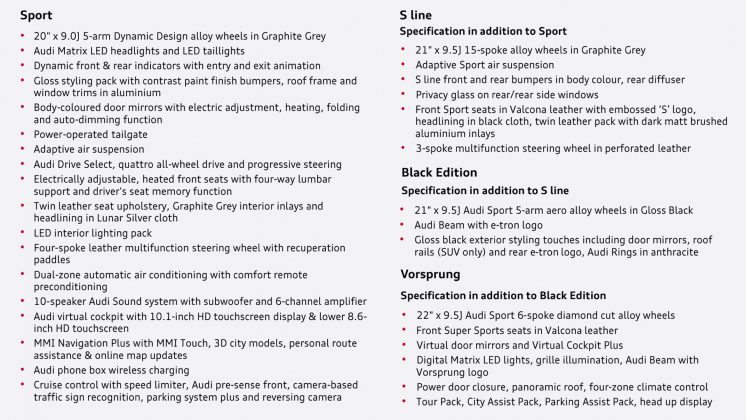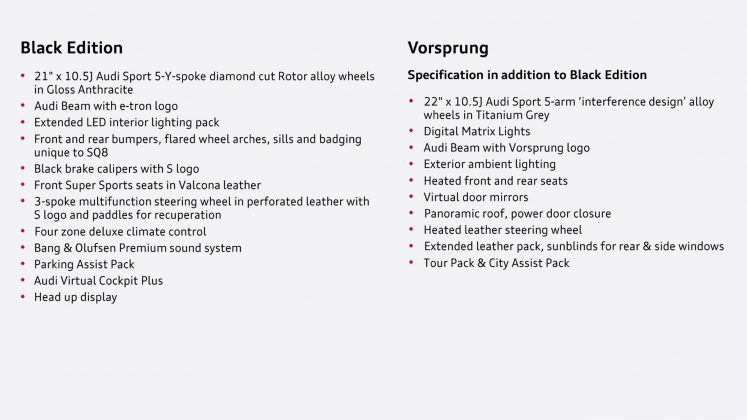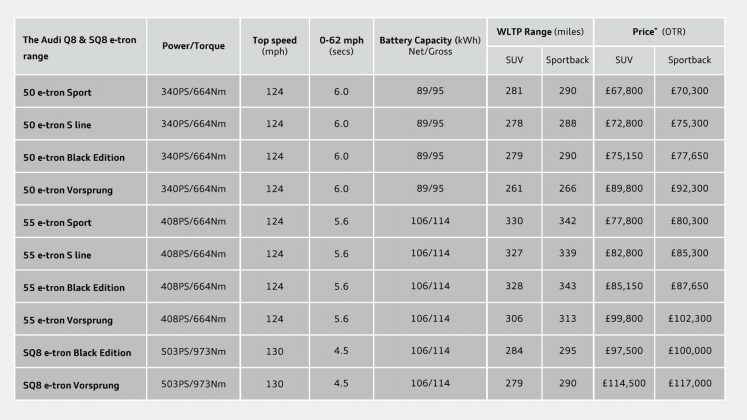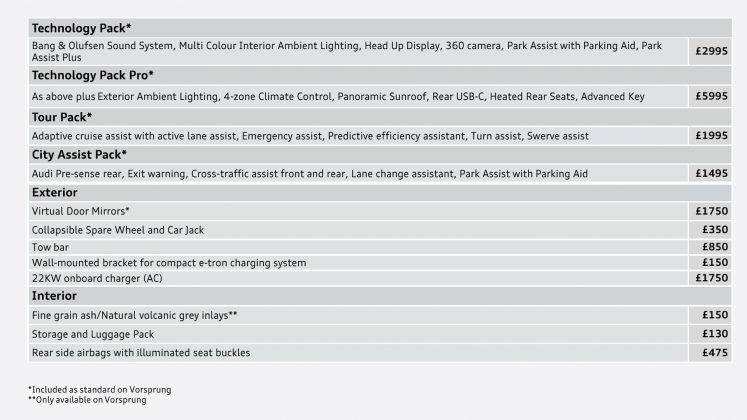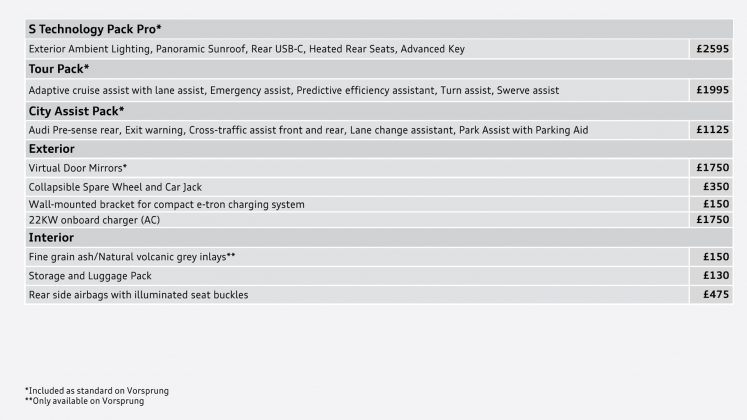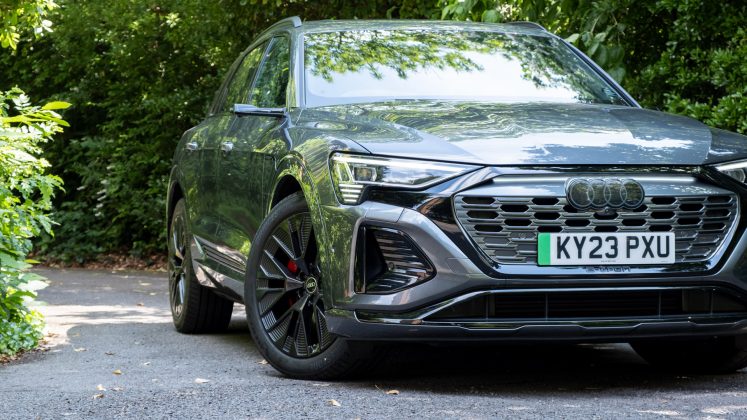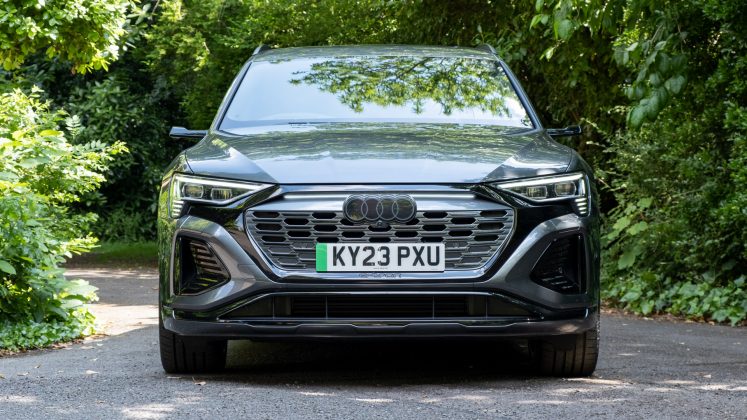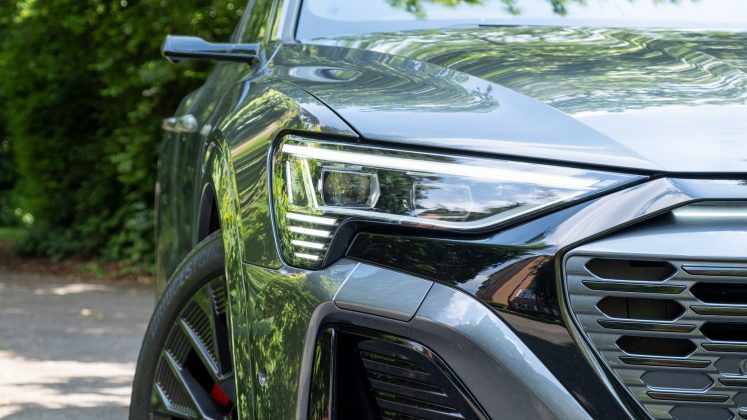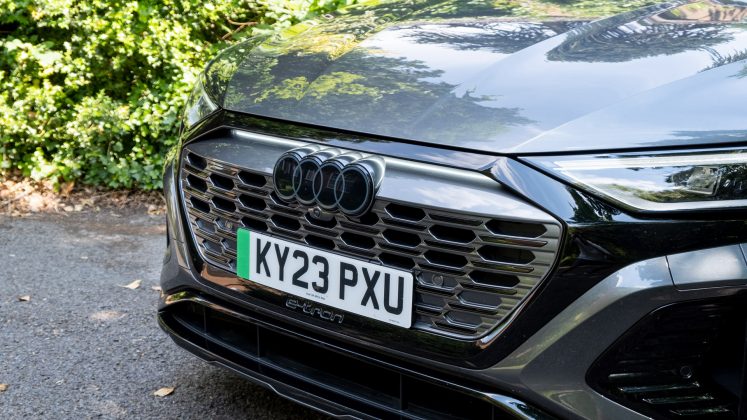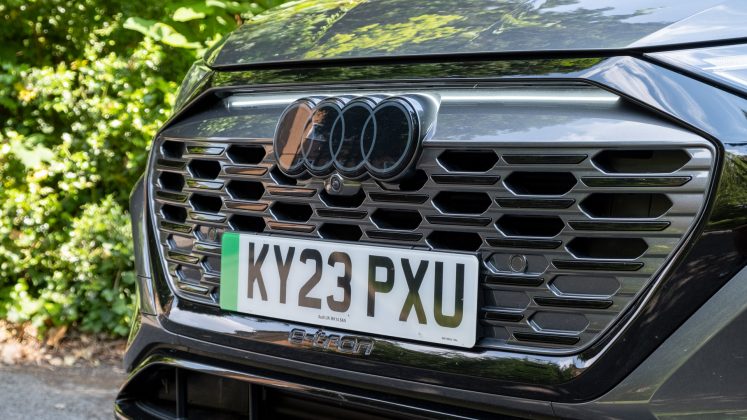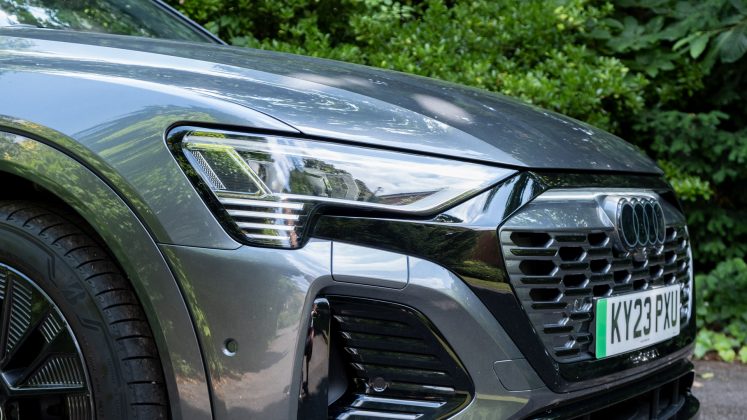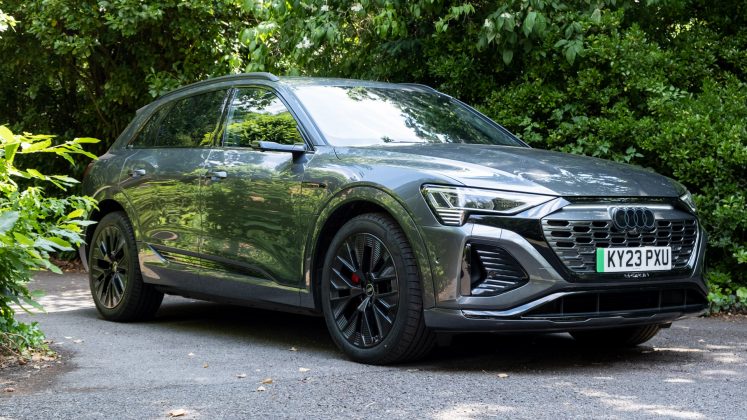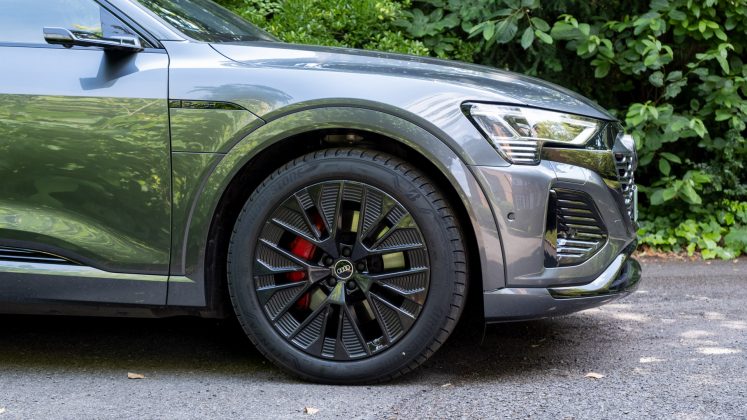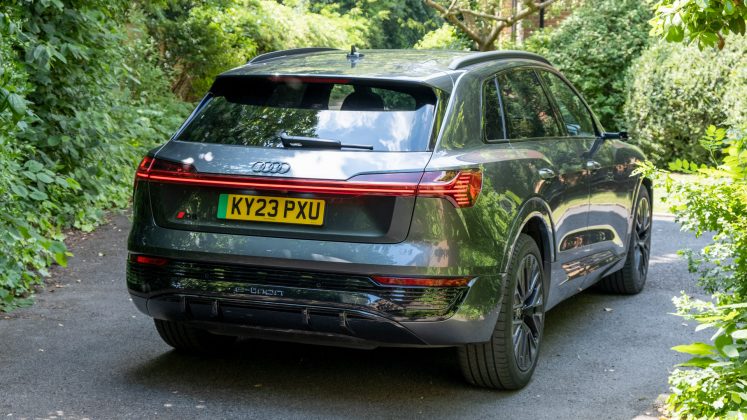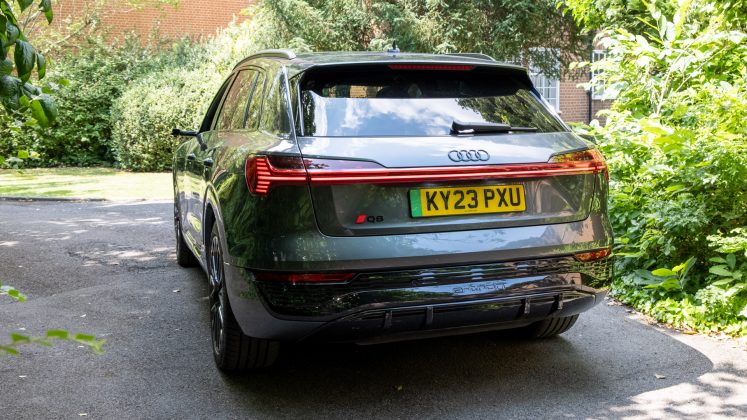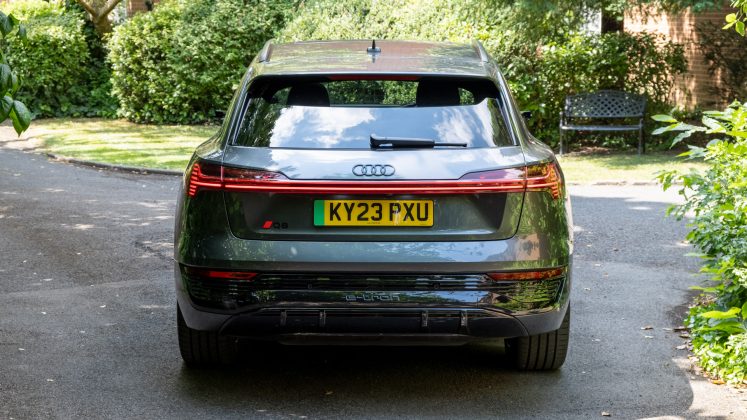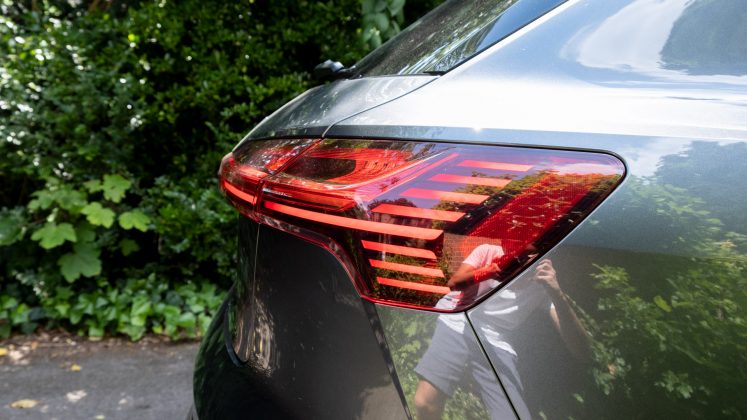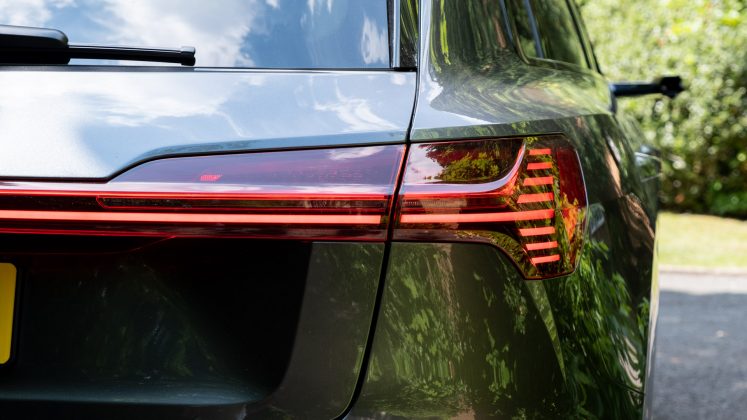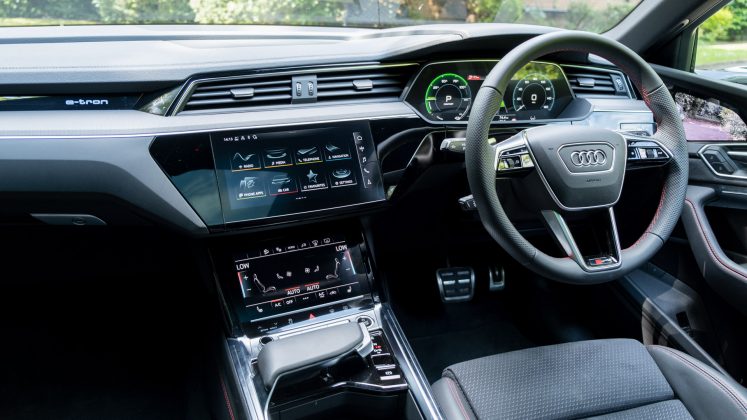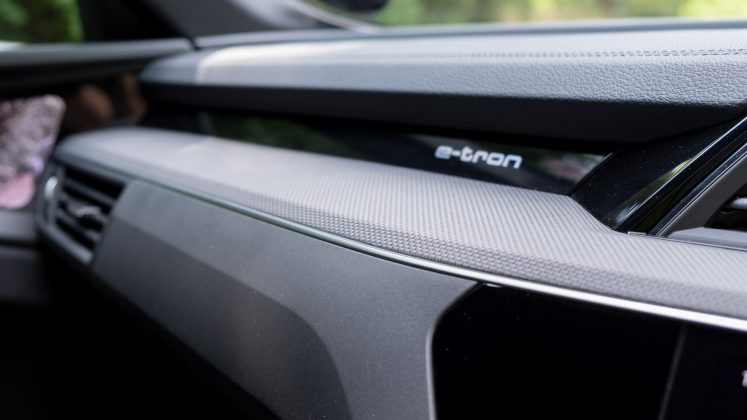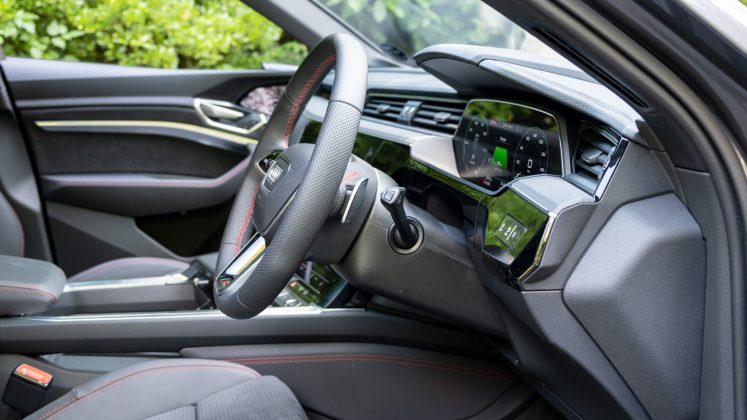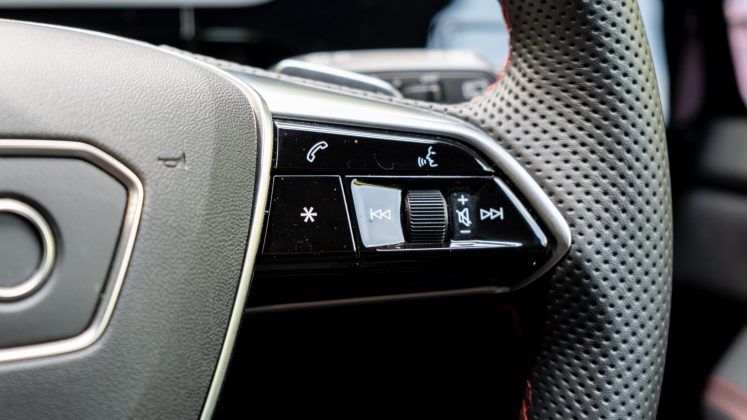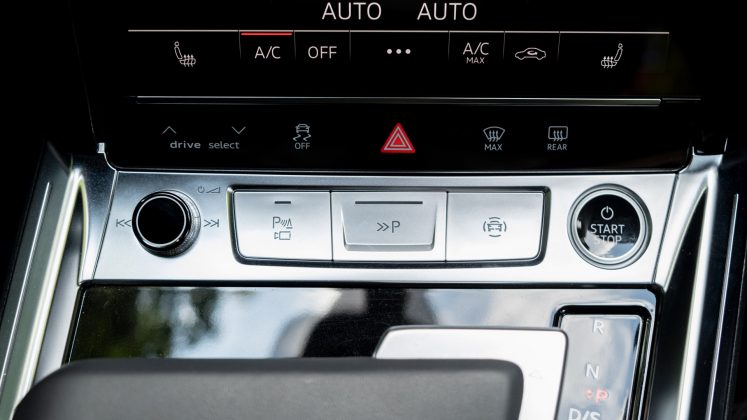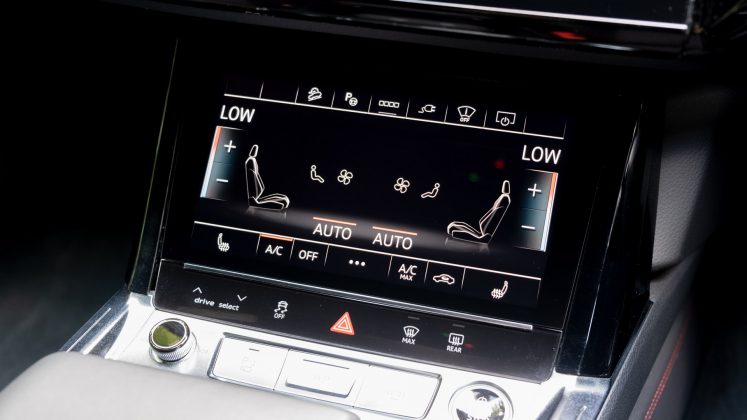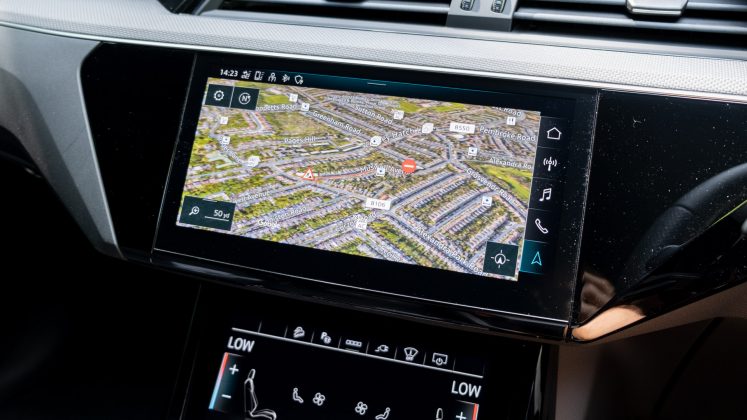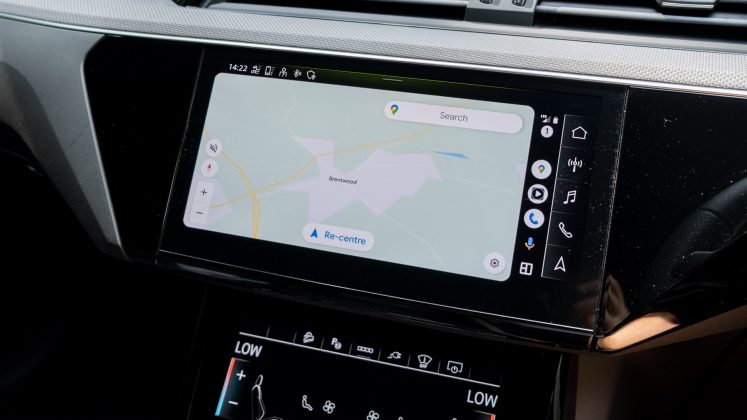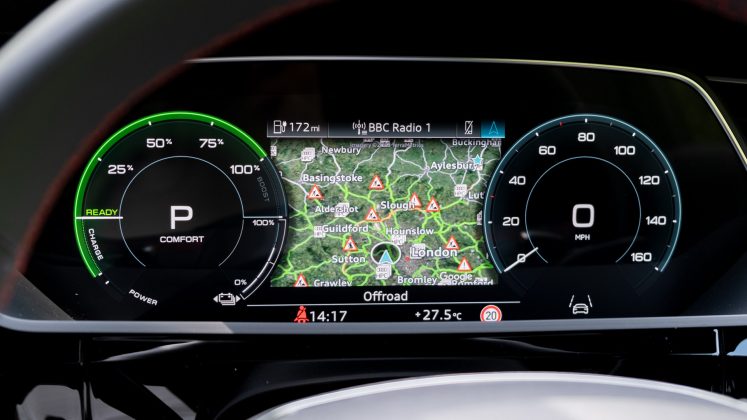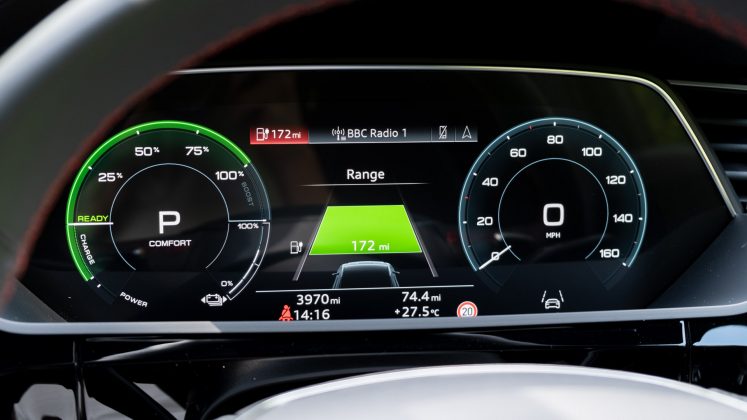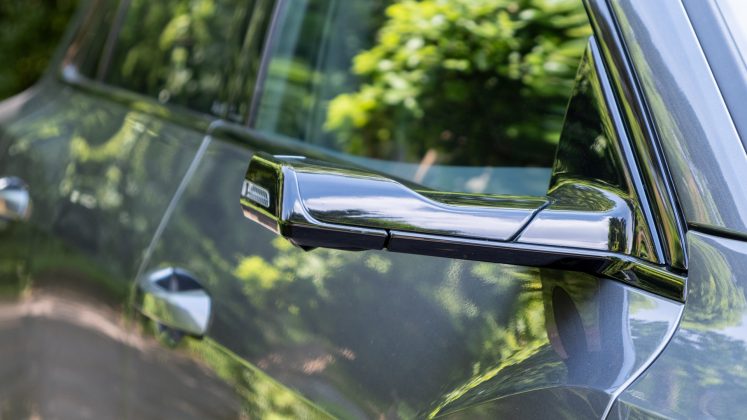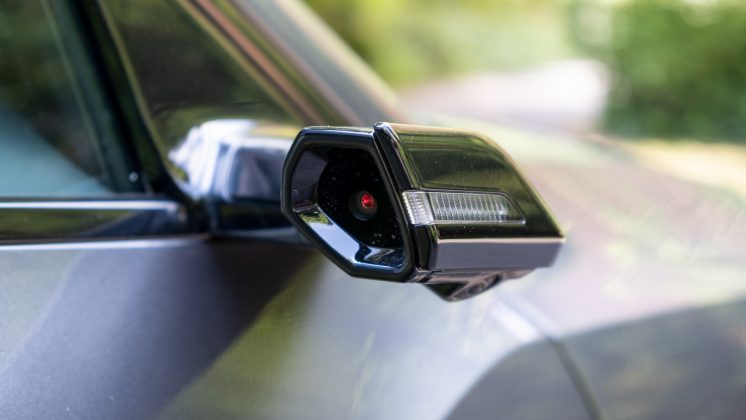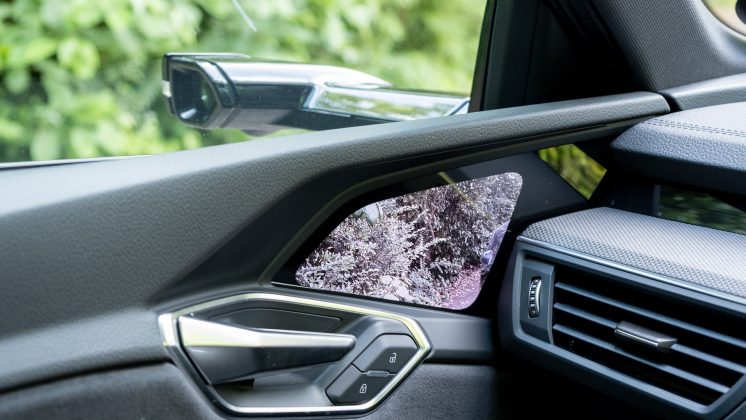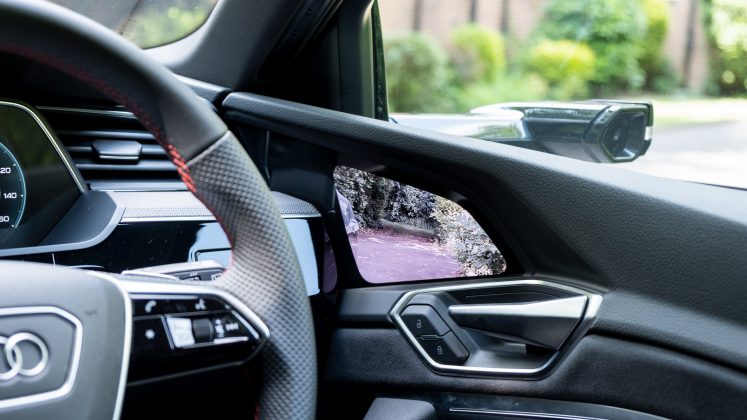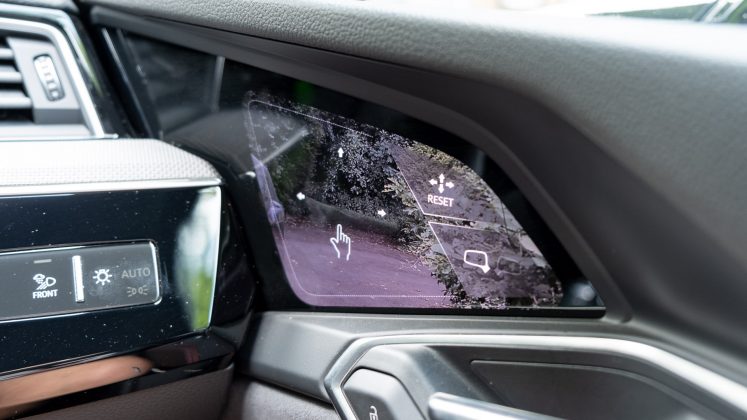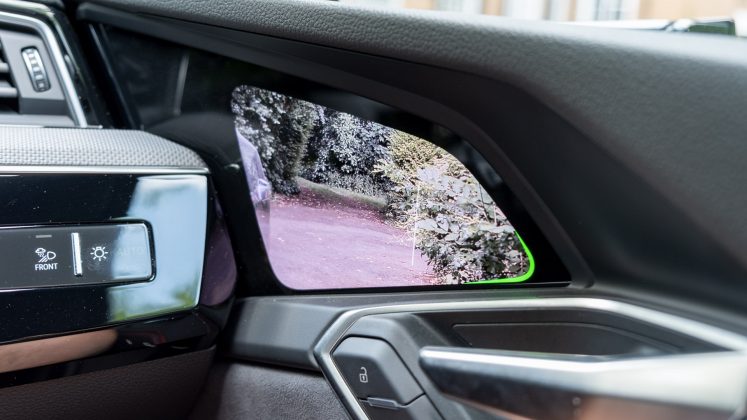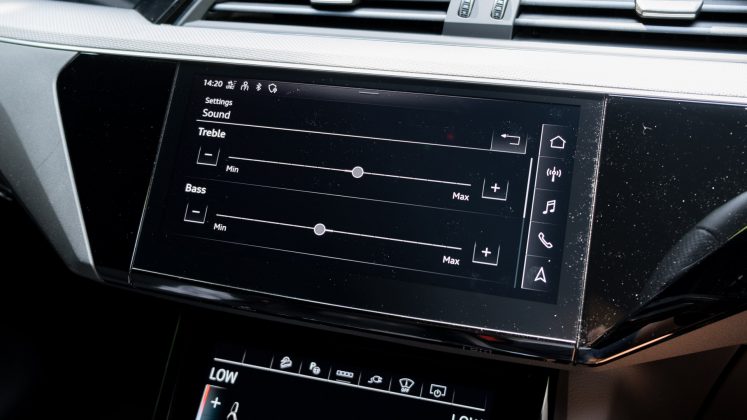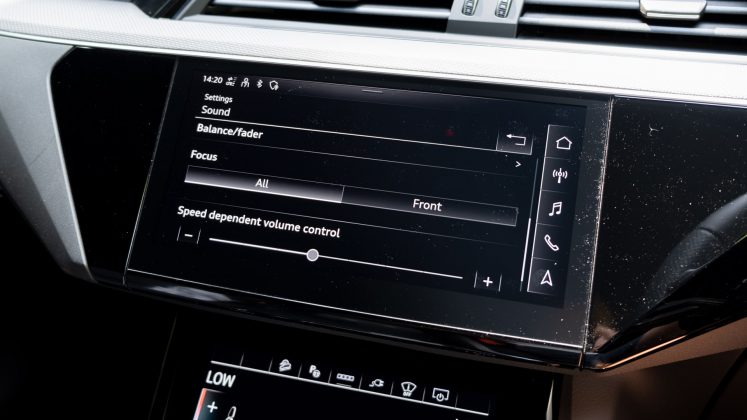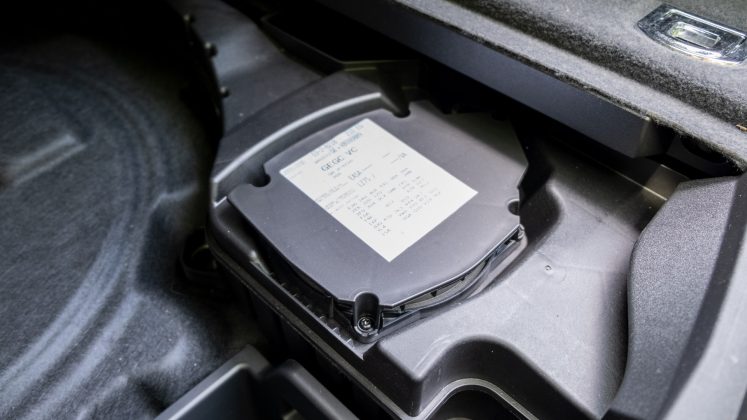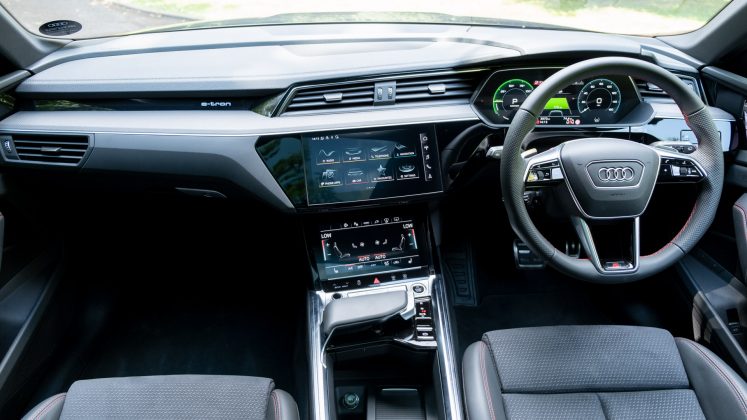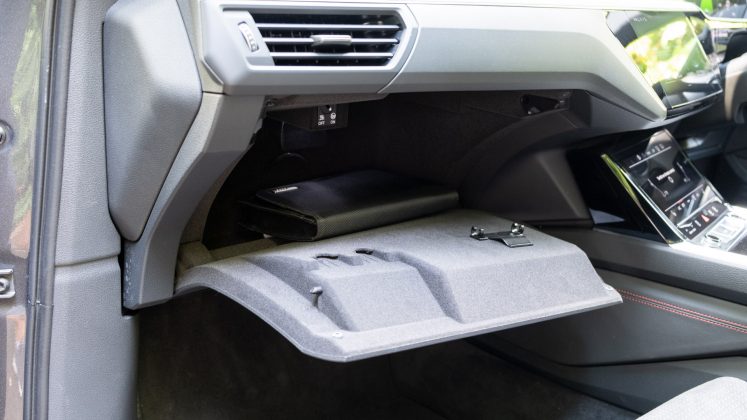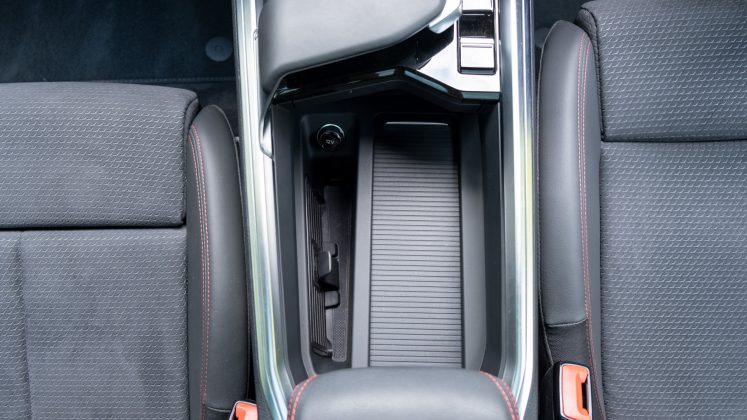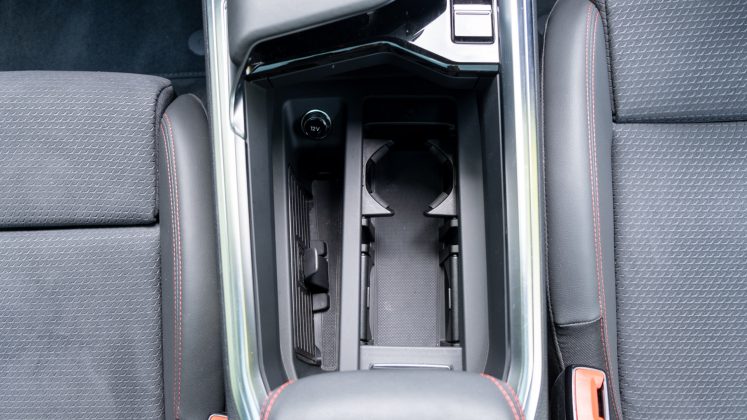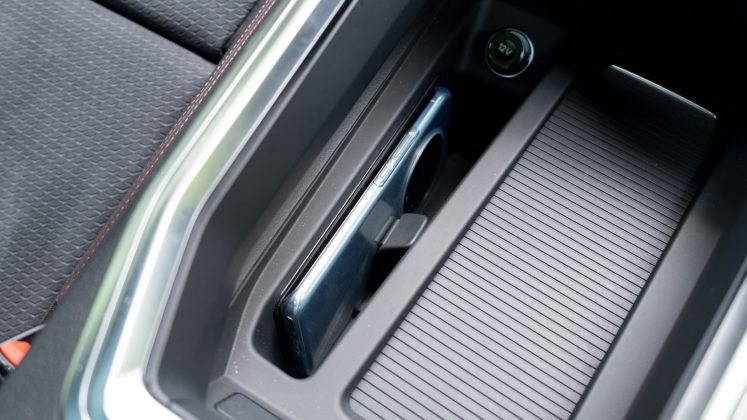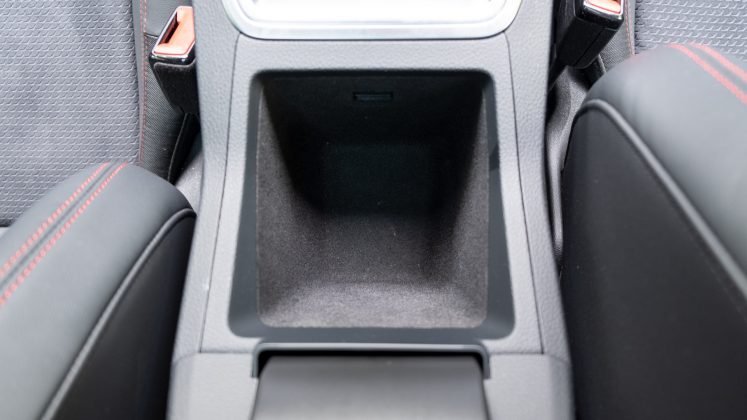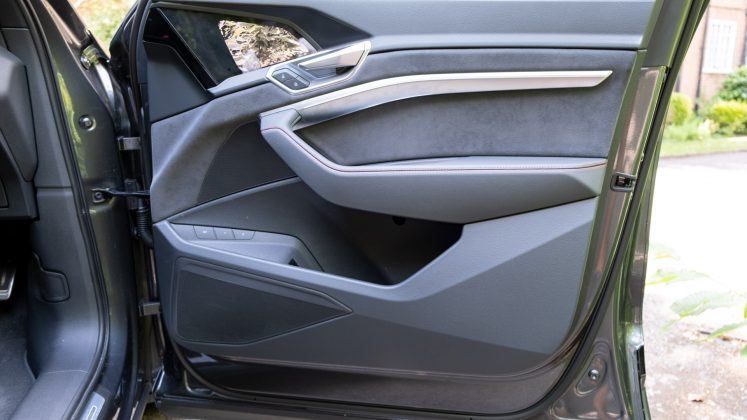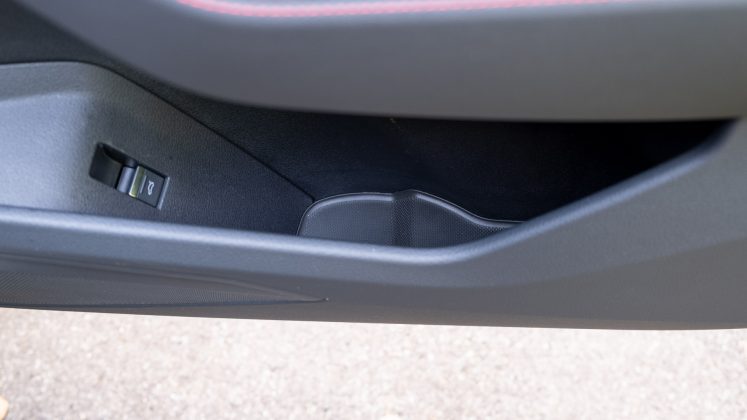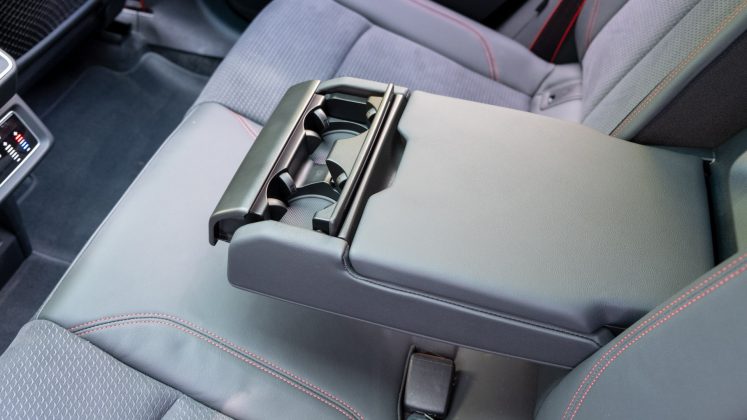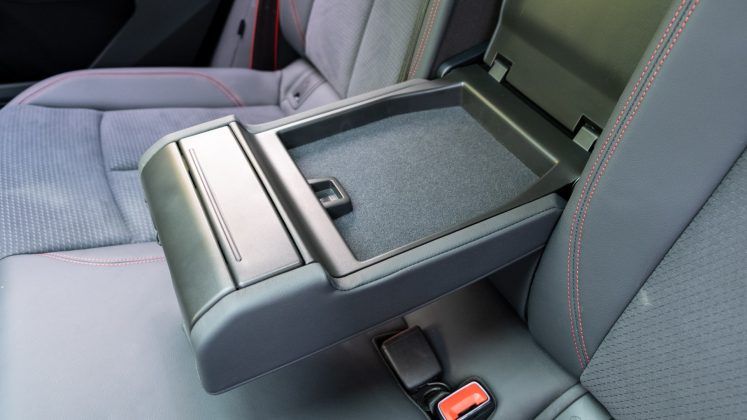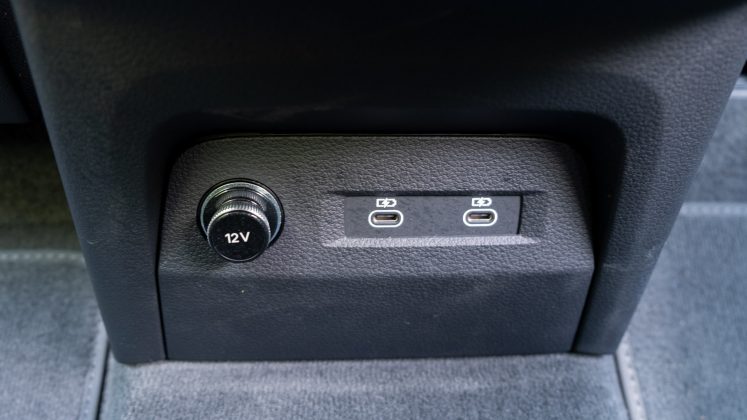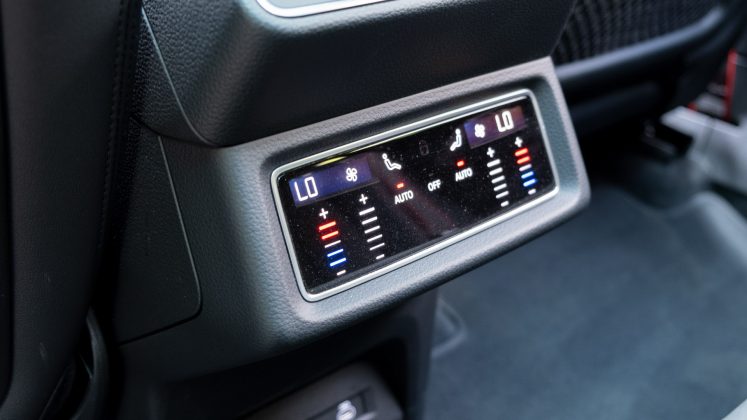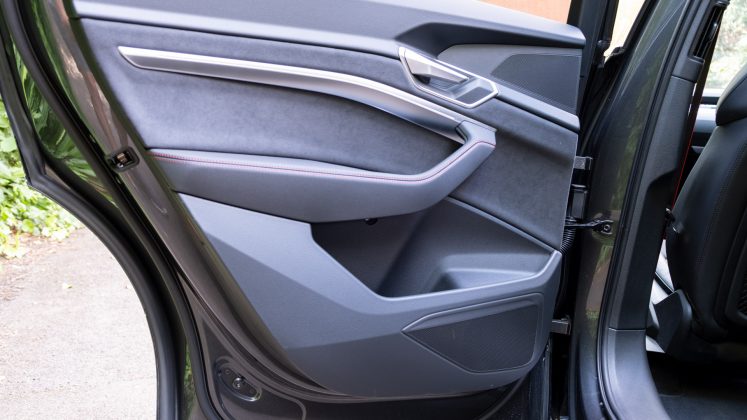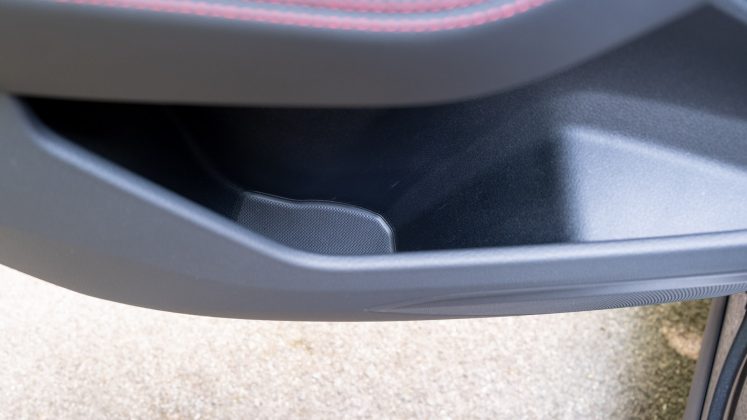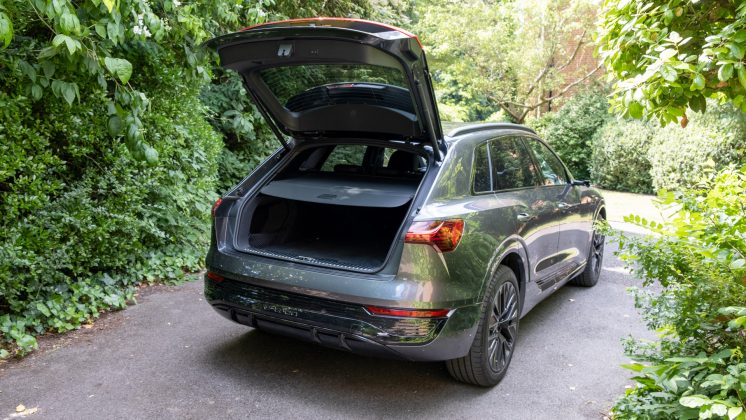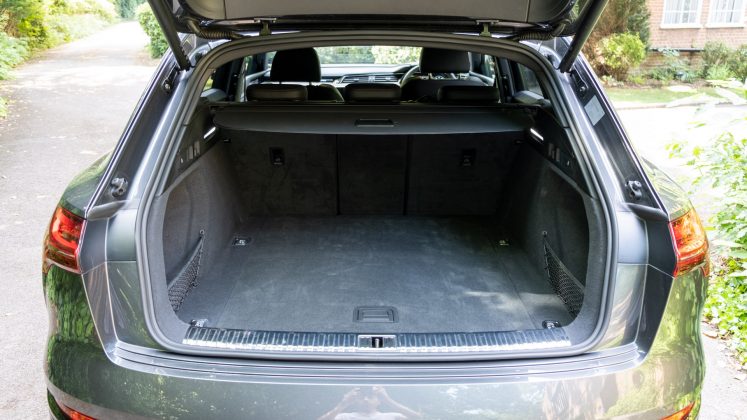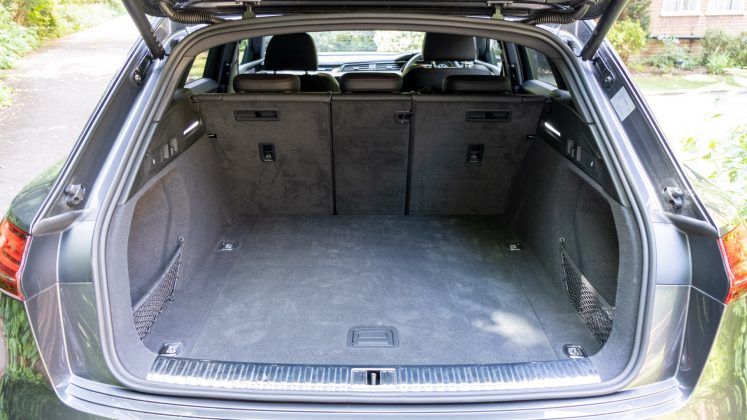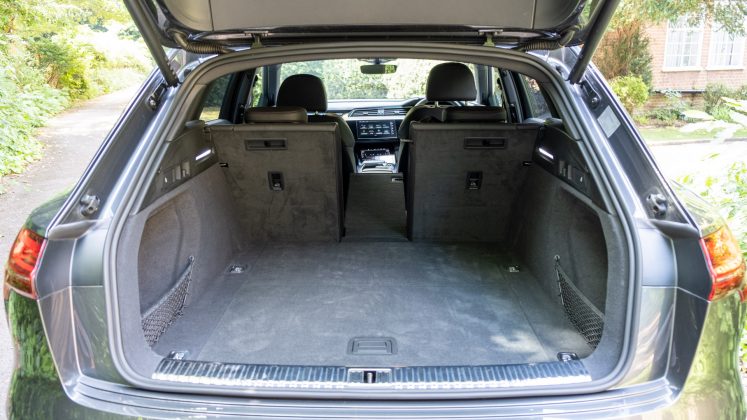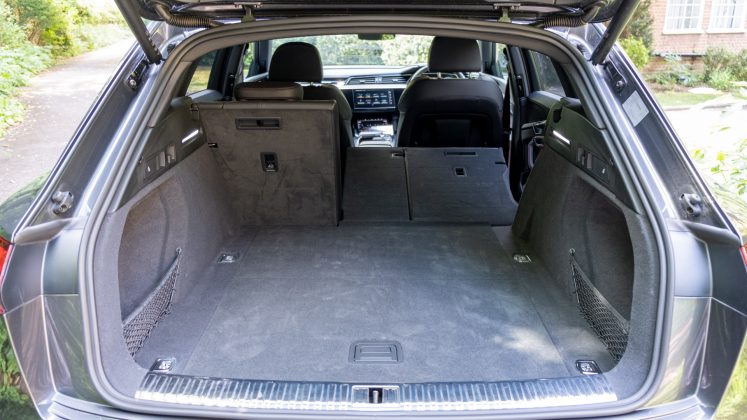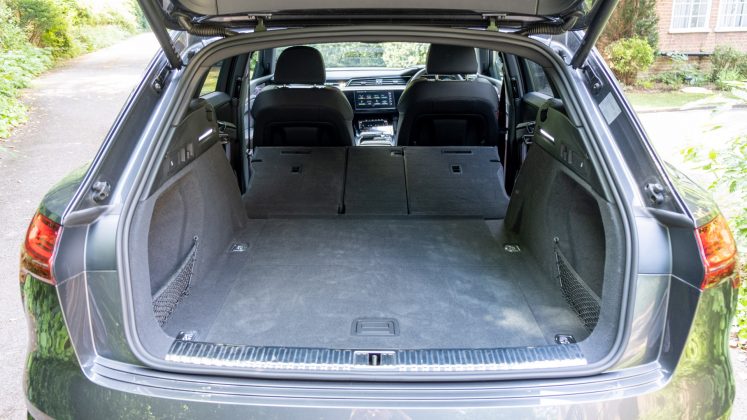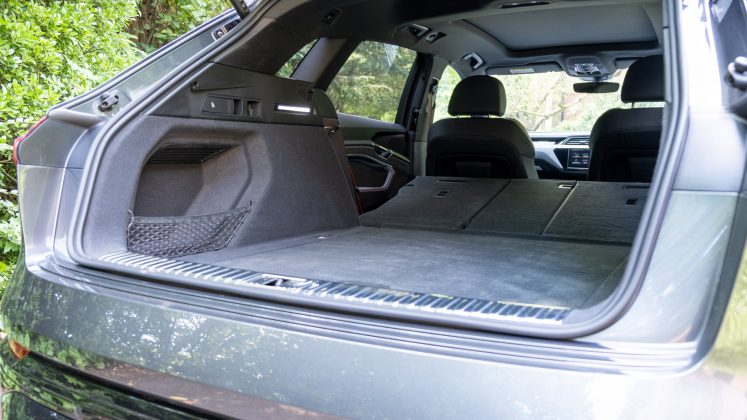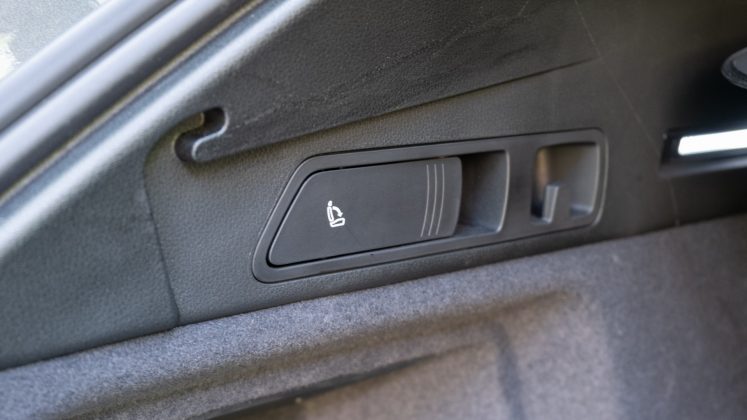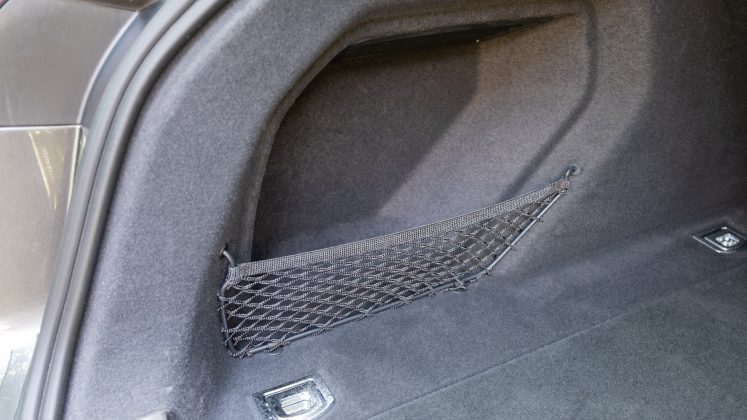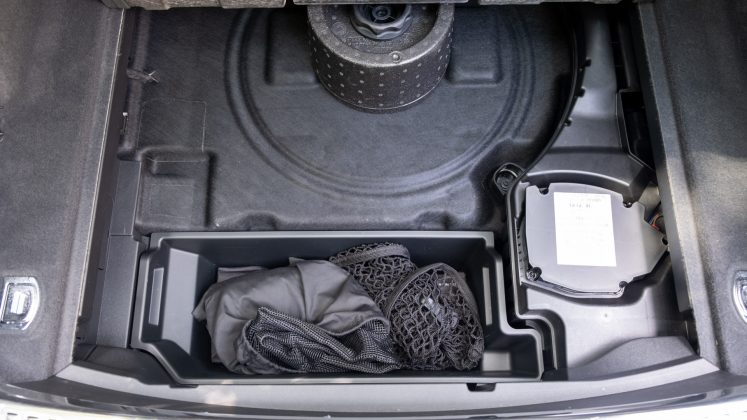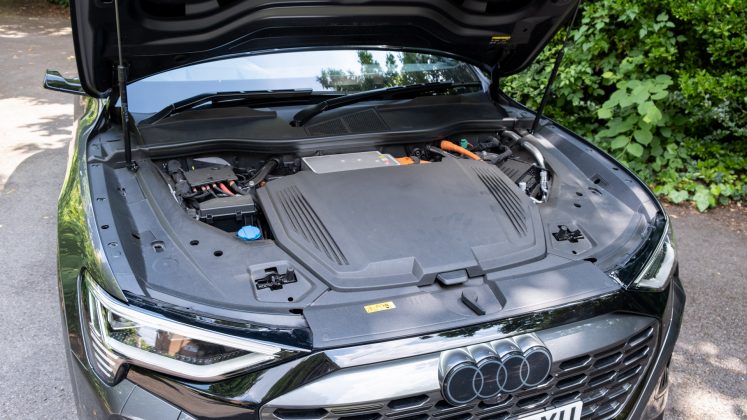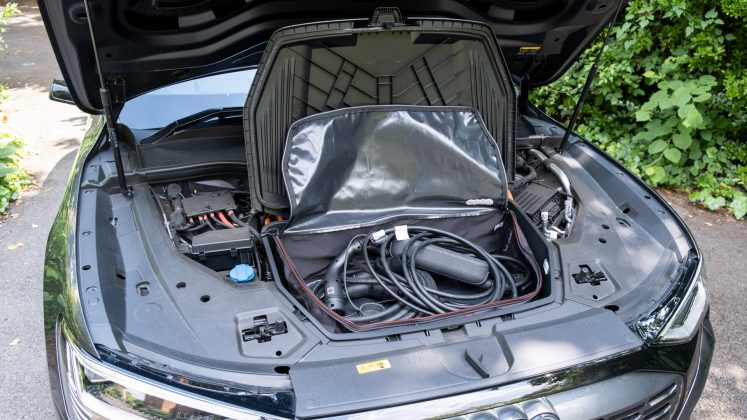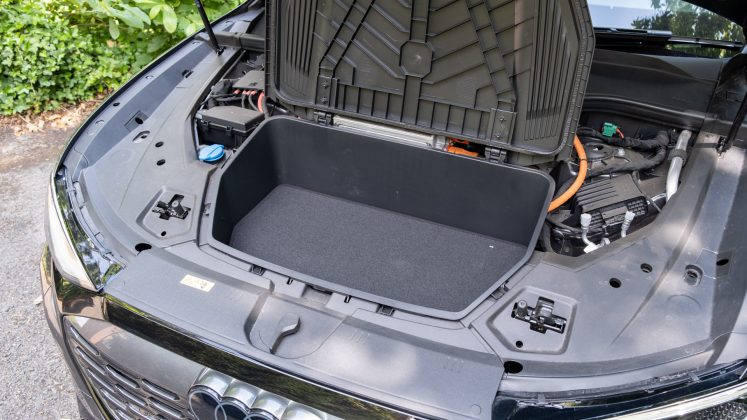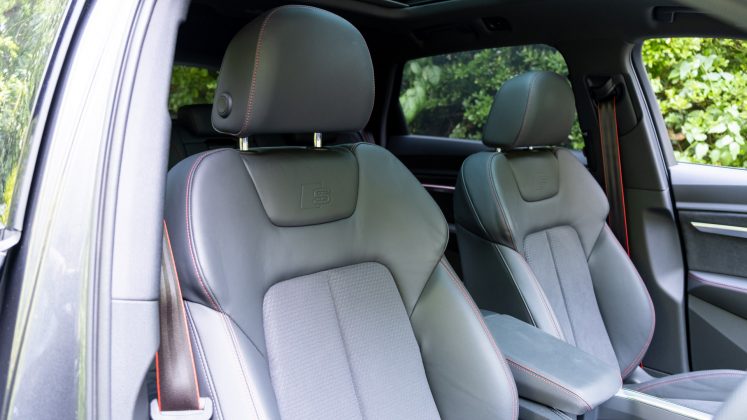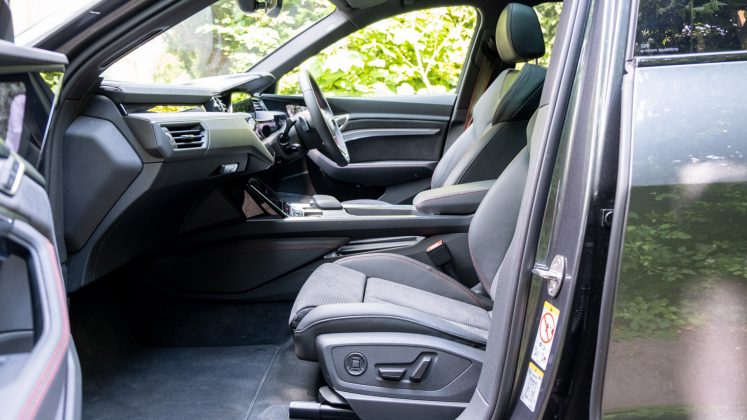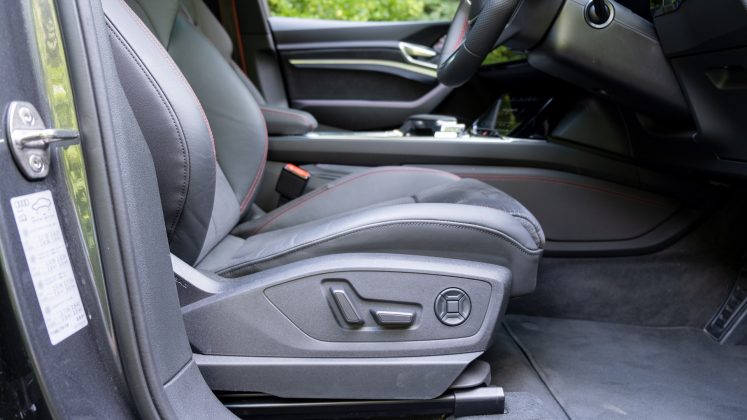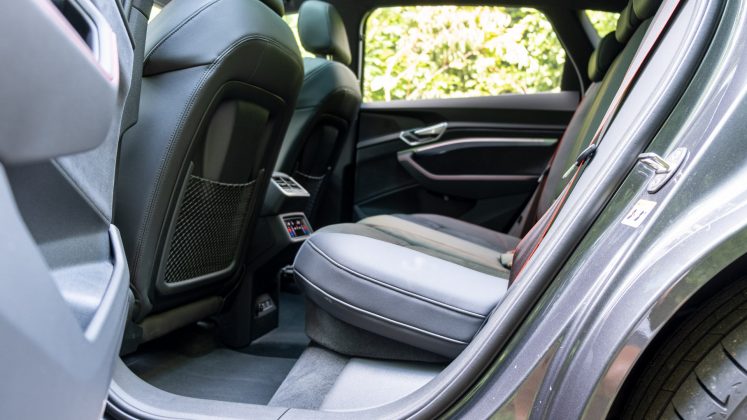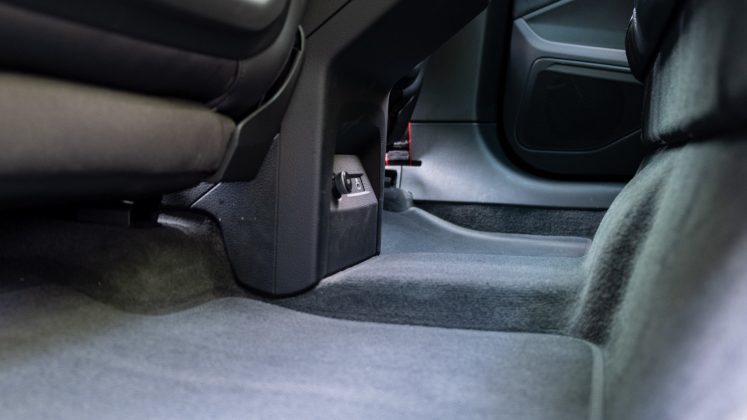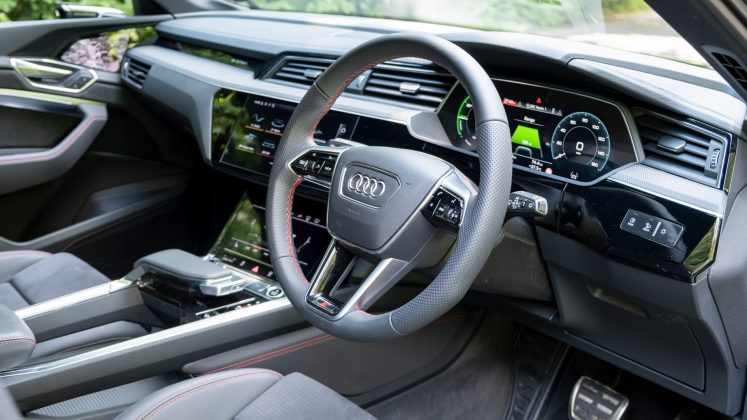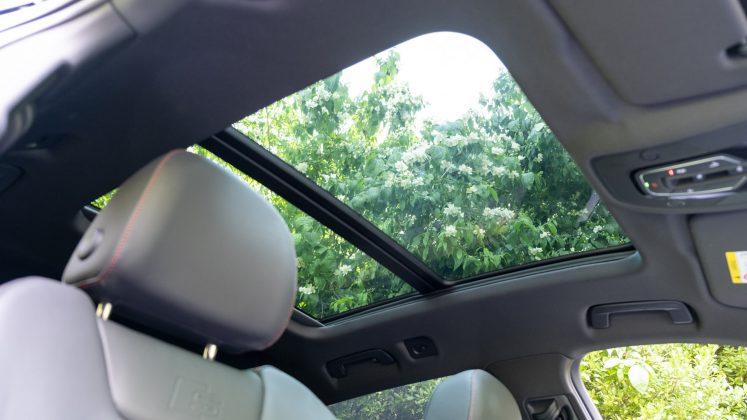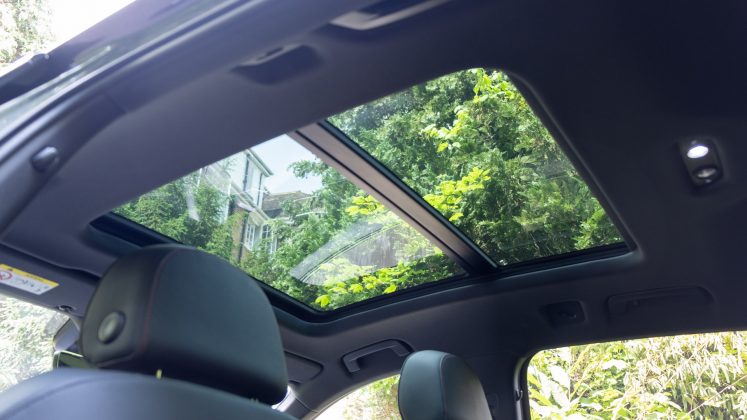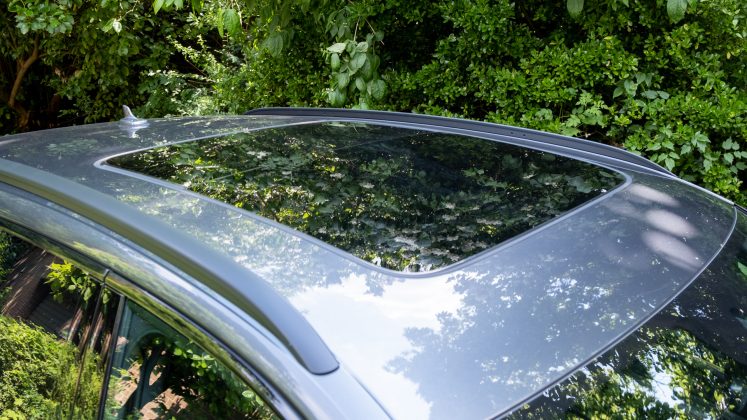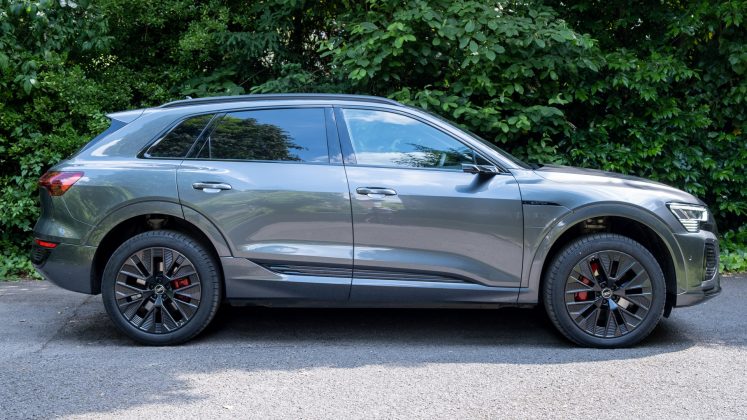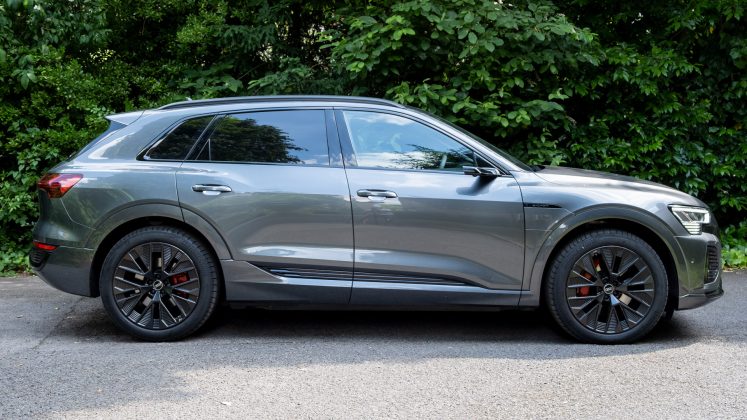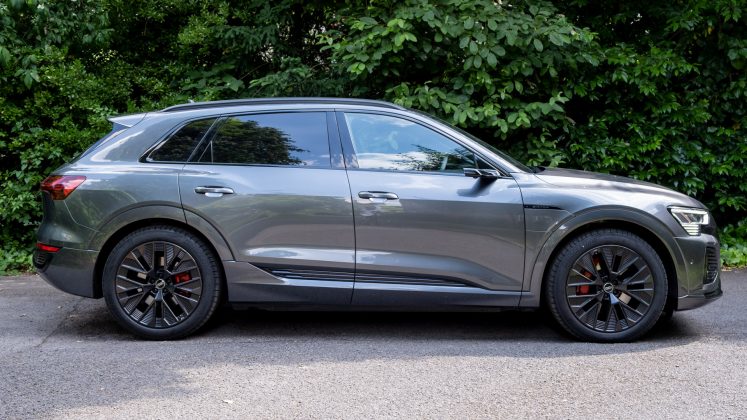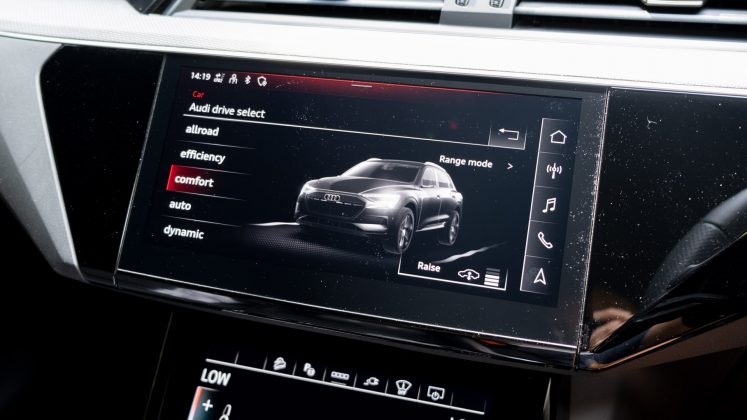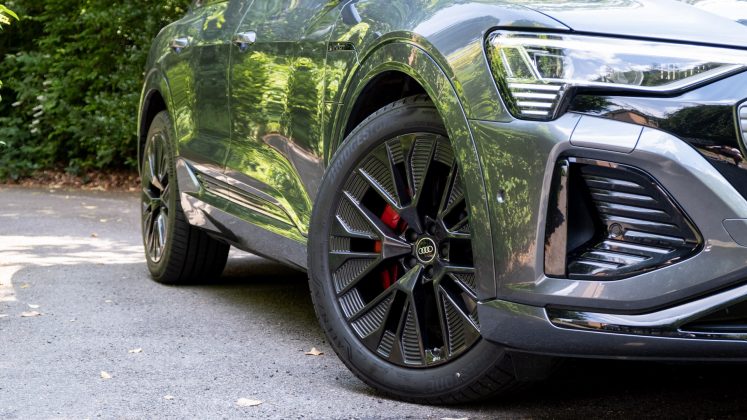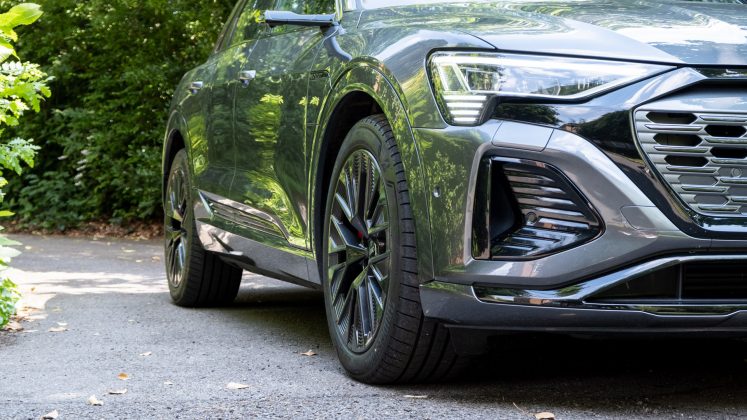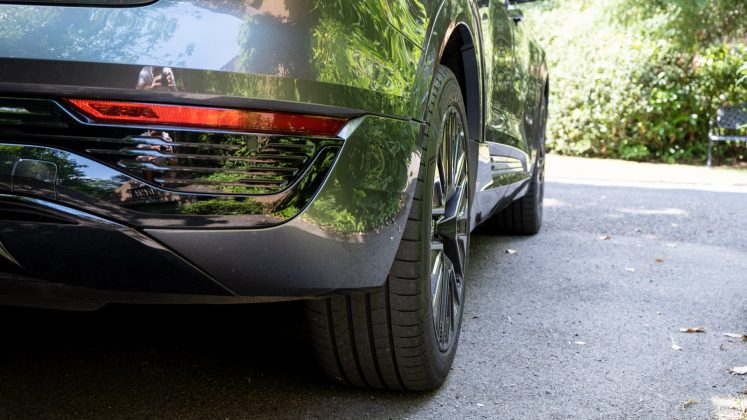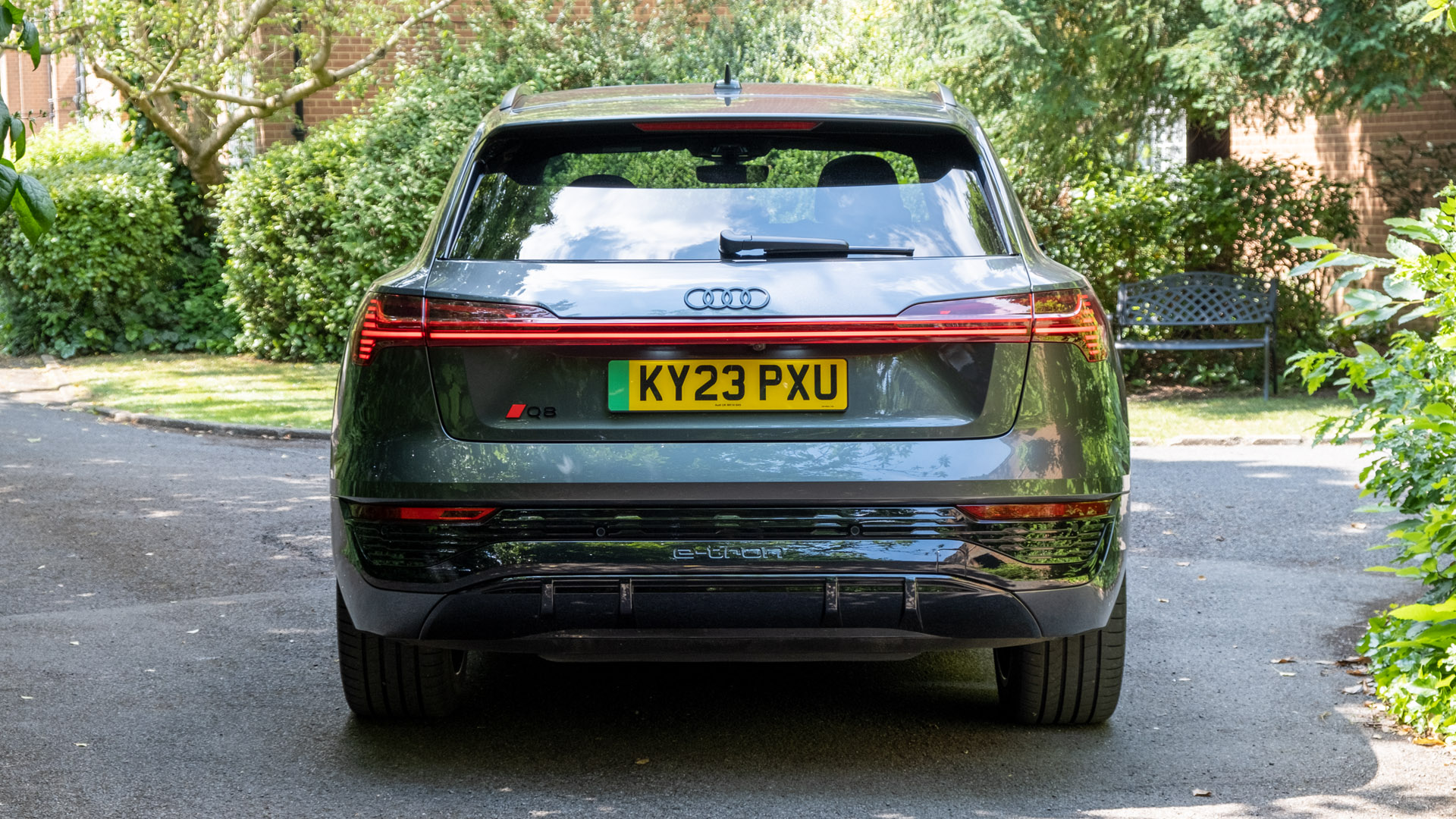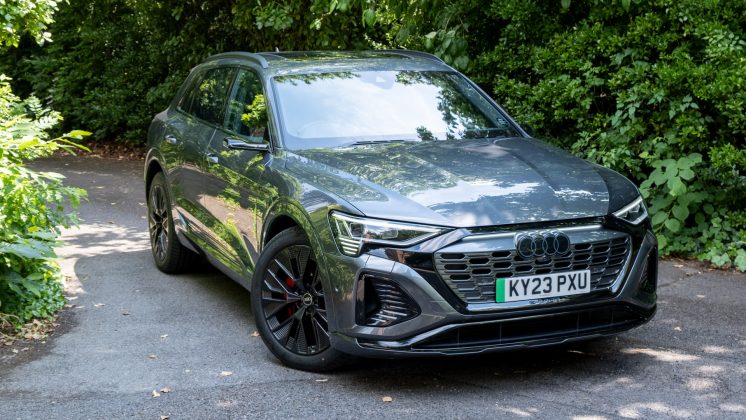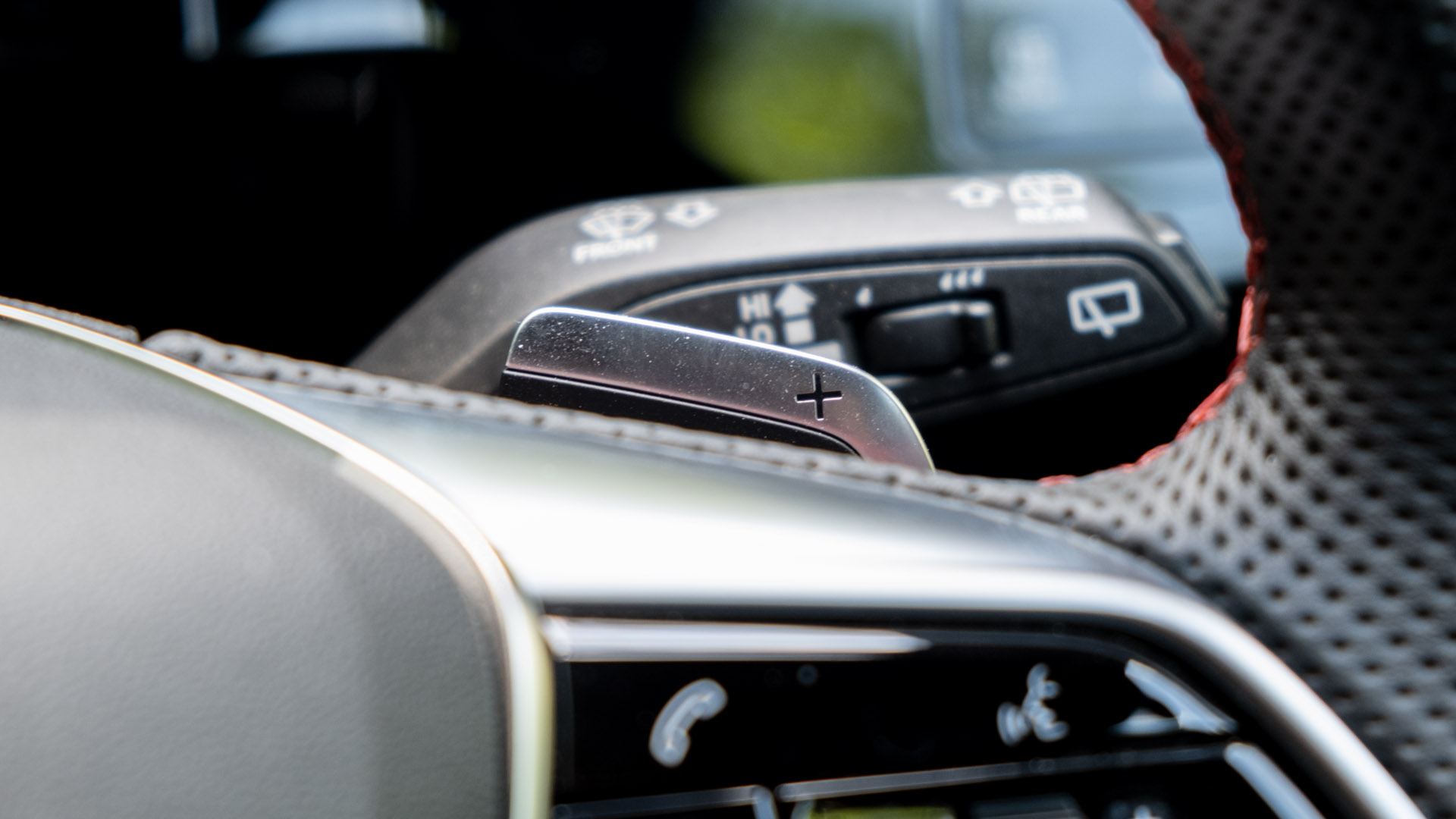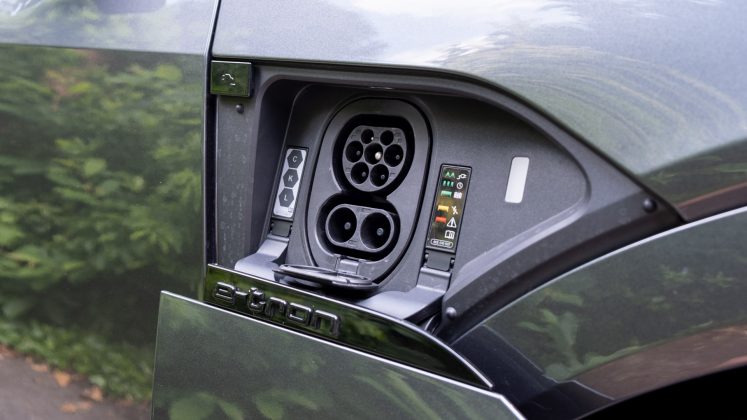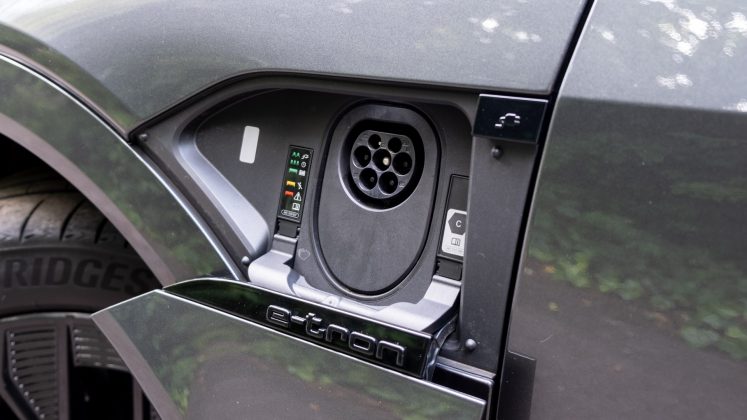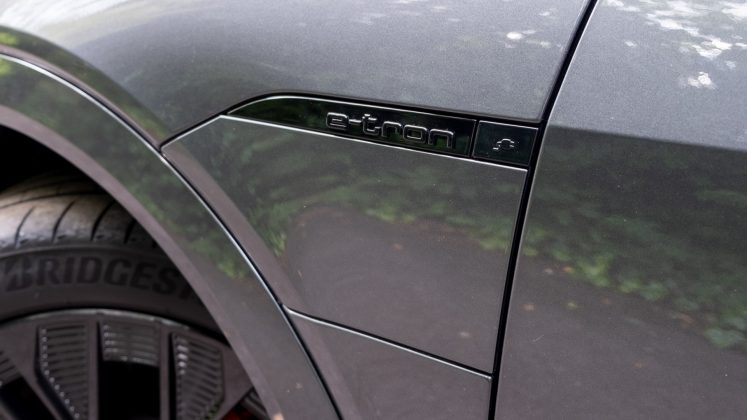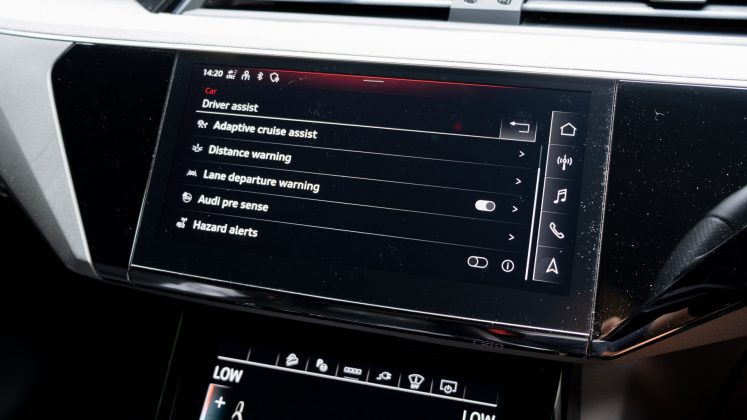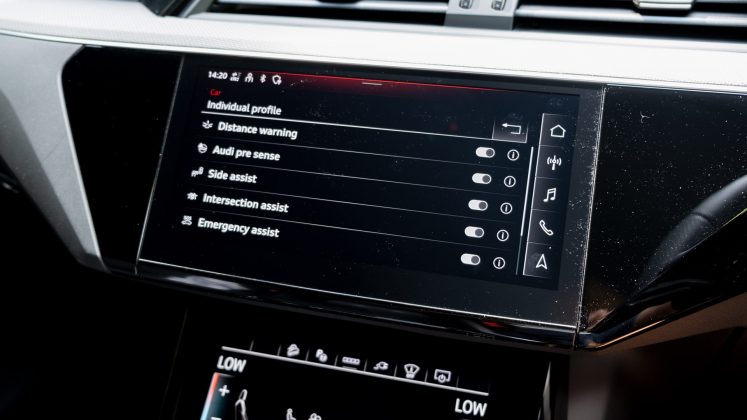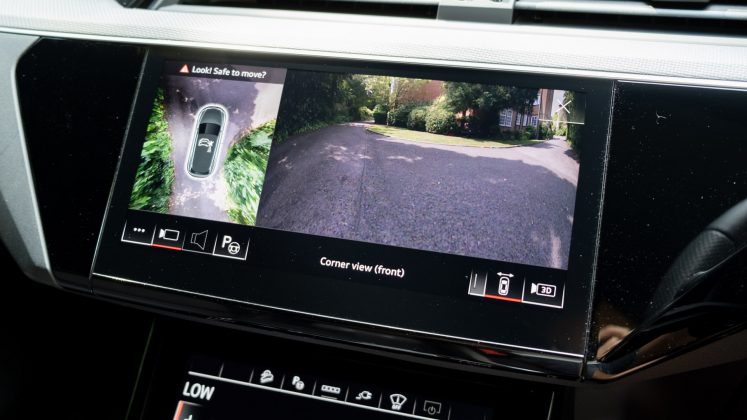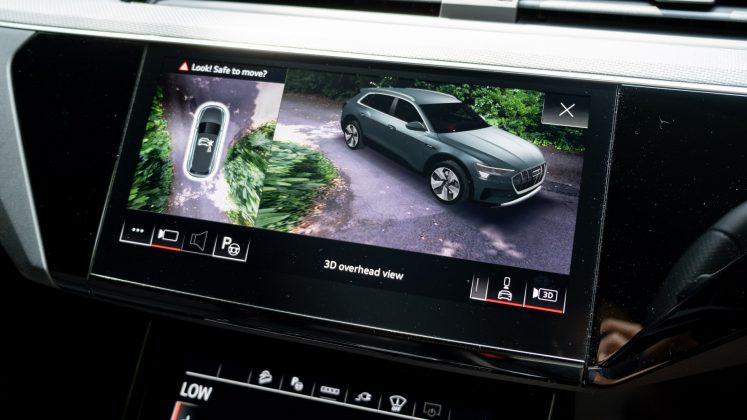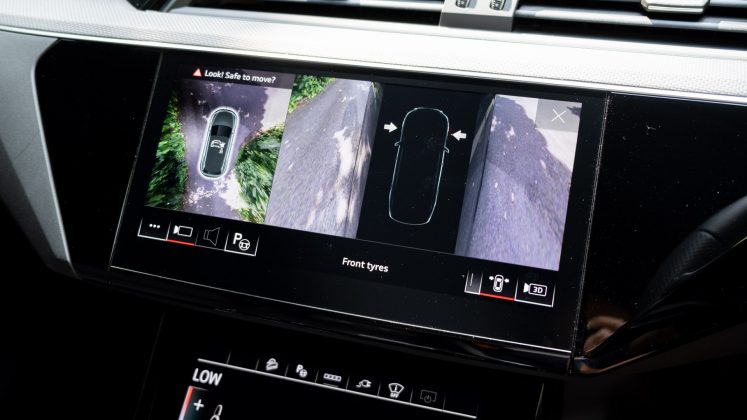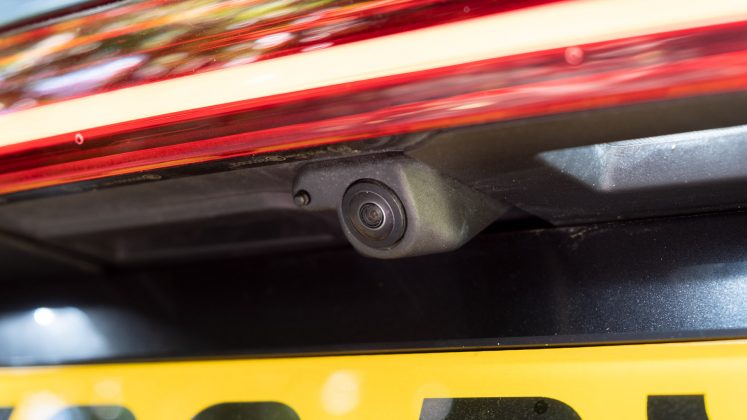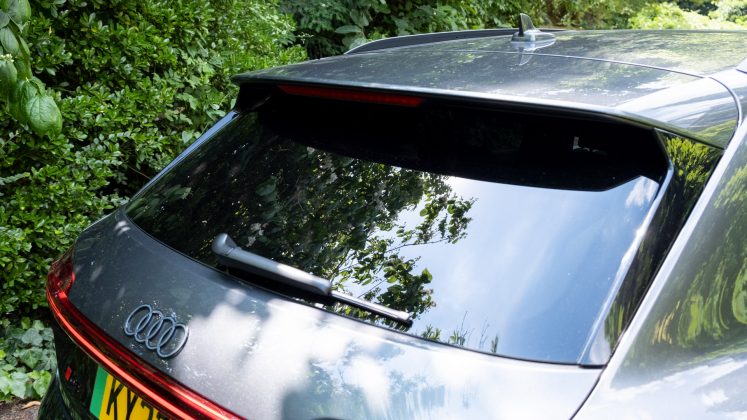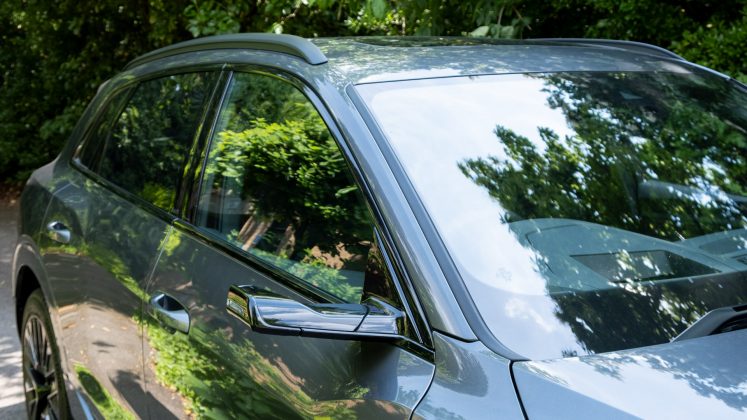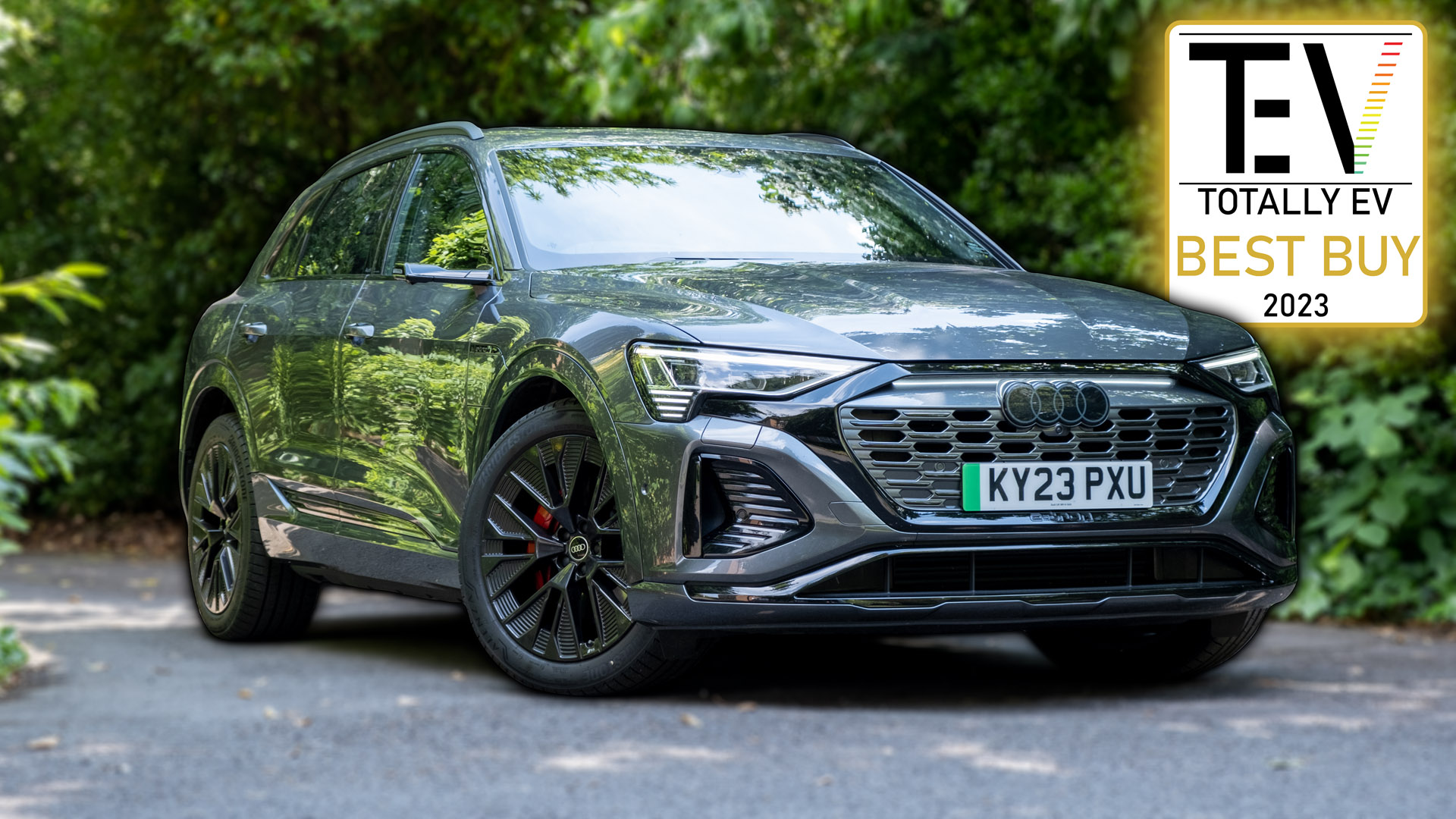The Audi Q8 e-tron and SQ8 e-tron follow on from the original e-tron and e-tron S, respectively. The former has two electric motors, while the latter has an additional one on the rear axle, taking the tally up to three. Both models are available as an SUV and Sportback configuration.
The headline addition is that the 55 Quattro now houses an even larger 114 kWh (106 kWh net) battery pack; up from 95 kWh (86 kWh net). This gives the Q8 e-tron a claimed range of 343 miles on the WLTP test cycle.
If you’d prefer to watch a review of the Q8 e-tron, head on over to our YouTube channel.
Audi Q8 e-tron price & competition
The Audi Q8 e-tron starts from £67,800 and rises up to a whopping £117,000 without options for the SQ8 e-tron Vorsprung. The model on review is a fully-loaded Launch Edition 55 e-tron S Line in a Daytona Grey; its on-the-road price is listed at a staggering £96,595. A breakdown of the trims can be found below (click to expand):
Find the best Audi Q8 e-tron deals
As for competition, there are numerous premium all-electric SUVs to consider: the Skoda Enyaq iV 80x from £51,275; the Volkswagen ID.4 GTX from £51,580; the Kia EV6 GT-Line AWD from £51,595; the Hyundai Ioniq 5 AWD Ultimate from £51,900; the Tesla Model Y Long Range from £52,990; the Mercedes EQA 350 4MATIC from £53,010; the Audi Q4 50 e-tron from £55,310; the Volvo XC40 Recharge Twin from £56,150; the BMW iX3 from £62,865; the Genesis Electrified GV70 from £64,409; the Jaguar I-Pace from £66,350; the Mercedes EQC 400 4MATIC from £70,035; the Ford Mustang Mach-E GT from £72,830; the Tesla Model X at around £101,880; and the BMW iX xDrive50 M Sport from £107,305.
Read next: Genesis Electrified GV70 review: Better than Audi?
Audi Q8 e-tron exterior review
Despite the vehicle’s steep asking price, the Q8 e-tron is certainly one of the better-looking electric SUVs. At the front, its headlights and accentuated front bumper look the part, while its large-sized grille suits the vehicle’s size – it’s 4,915mm long, 2,189mm wide (1,937mm excluding mirrors) and 1633mm tall.
It’s similarly stylish at the rear with the taillights stretching the vehicle’s width and an integrated spoiler giving it that extra bit of pizzazz. From the side, the 20″ alloys that come fitted as standard (up to 22″ in the Vorsprung model) provide that sporty flair, and the flared side skirts and body-coloured wheel arches complete its look. As for your colour options, Magnet Grey comes as standard but the metallic and pearl finishes cost an additional £750-£1,495; the Audi exclusive colours start from £3,495.
Read next: Jaguar I-Pace review: Better than newer rivals?
Audi Q8 e-tron interior review
Step inside, and you’ll find the Q8 e-tron still retains that premium look and feel; from the stitching work on the upholstery and steering wheel to the recycled materials used throughout the cabin. It’s classy and among the most lavish interiors found in an SUV, be it electrified or not.
Moving onto technology, Audi includes a 10.1″ display, which is planted at a slight angle at the centre of the dashboard. The infotainment system is extremely responsive and makes for easy navigation thanks to Audi’s Multi Media Interface (MMI). Should you want, there’s also the ability to enable haptic feedback, which gives you the sensation of pressing a physical button, rather than tapping it virtually.
The same technology applies to the secondary 8.6″ display. The smaller panel, located under the 10.1″ display and conveniently in front of a small wrist rest, is dedicated to climate controls. Here, you’ll be able to adjust the fan speed, temperature and initiate the front-heated seats, which come fitted as standard.
As for the driver’s display, the 12″ instrument cluster provides you with all the key driving information and allows you to see the vehicle’s built-in navigation system. Alas, Android Auto and Apple CarPlay navigation data aren’t fed through to the elongated display. Audi’s MMI supports both third-party operating systems over a wired and wireless connection. The former is preferable for superior audio fidelity.
Speaking of which, the Q8 e-tron comes fitted with a rather disappointing 10-speaker 180-Watt system. Should you want the 16-speaker Bang & Olufsen sound system that outputs 705 Watts, you’ll have to splurge out an additional £2,995 on the ‘Technology Pack’ or upgrade to the Vorsprung trim as it has the B&O system fitted as standard. If you’d like to know how the stock system performs, watch our dedicated review of the audio system on YouTube.
Aside from the upgraded audio system, the Technology Pack also adds a Head-Up Display (HUD). This projects key driving information, such as your traversing speed, the safety systems in operation and can display warnings too. Yet again, you’ll find its inclusion within the more expensive trims.
On that note, the Vorsprung trim comes fitted with the Virtual Door Mirrors. These are otherwise a £1,750 option. While these do help the vehicle’s aerodynamics, the placement within the vehicle is a cause for concern. Unlike the Hyundai Ioniq 6 or Honda e, which opt to have their screens cleverly placed at the extremity of the dashboard, the ones found within the Audi are by the door mirror triangles. This means it’s even harder to check your surroundings and as you’re glancing even further away from the road, it could lead to an unwanted accident.
Simply put, we’d highly recommend skipping this option and if you’re set on the top-spec Vorsprung trim, you can opt for the ‘Standard Black Door Mirrors’ at no additional cost.
Read next: Audi e-tron S review: The tri-motor electric SUV
Audi Q8 e-tron storage review
The Q8 e-tron makes up for its precarious mirror design with a spacious interior. The door bins can easily accommodate a 500ml bottle alongside small-sized valuables and the glove box is plenty large. Towards the centre console, you’ll find a retractable cover that reveals two foldable cupholders and beside it, a 12V socket to plug in a dash cam or to provide additional power to a smartphone. There are also two USB Type-C ports (data and charging) found in this area.
In terms of practicality, Audi has cleverly cut out a hole by the centre armrest compartment so that you can safely store away your smartphone when it’s plugged in. There are a further two Type-C ports (for charging only) and a 12V socket found by the rear of the centre console. You’ll also find two cupholders and a fancy fabric-lined compartment in the pull-down rear armrest.
What really stands out, however, is the sheer amount of space in the boot. There’s 569 litres with the seats up and a whopping 1,637 litres with them folded down – while that’s smaller than the original Audi e-tron and e-tron S (rated at 660/1,725 litres), it’s still plentiful.
Here’s how it compares to its rivals: Tesla Model Y (854/2,100 litres); Skoda Enyaq iV (585/1,710 litres); VW ID.4 (543/1,575 litres); Hyundai Ioniq 5 (520/1,587 litres); BMW iX3 (520/1,560 litres); Jaguar I-Pace (656/1,453 litres); Audi Q4 e-tron (520/1,490 litres); MG5 EV estate (464/1,456 litres); Kia e-Niro (451/1,405 litres); Peugeot e-2008 (434/1,467 litres); Volvo XC40 Recharge (452/1,328 litres); MG ZS EV (448/1,375 litres); Kia EV6 (490/1,300 litres); Ford Mustang Mach-E (402/1,420 litres); Kia Soul EV (315/1,339 litres); Mercedes EQA (340/1,320 litres); Citroen e-C4 (380/1,250 litres).
There’s further storage at the front of the vehicle, too – 62 litres to be specific, which will suffice for the vehicle’s charging cables or a small grocery shop. However, unlike the vehicle’s tailgate, it’s not electronically operated, which means you’ll need to prop open the frunk via a lever found by the driver’s side door; the same you’d find when opening the engine compartment on a combustion vehicle. As such, we prefer storing the Mode 3 cable (Type 2 to Type 2) within the underfloor compartment at the rear of the vehicle.
Elsewhere, Audi’s electric tailgate has a hatchback design, making it easy to load in and out goods. Combined with its retractable boot cover, 40:20:40 split-folding rear seats that have a release latch located in the boot, a flat loading bay, a large underfloor compartment (large enough even for a spare tyre) and side storage bays, the Q8 e-tron is extremely practical.
Read next: Skoda Enyaq iV review: The Volkswagen ID.4 alternative
Audi Q8 e-tron comfort review
But, its large boot isn’t the only selling point, as the German automaker’s cabin is plenty large too. Both headroom and legroom are excellent throughout the cabin, allowing for 6-foot 4-inches (193cm) individuals to feel comfortable no matter where they’re sat.
Although, it’s worth considering that the Q8 e-tron, much like its predecessor, can only seat up to five individuals. Larger-sized families might want to consider the Tesla Model X, which can be customised in a six or seven-seater configuration.
If you are using the vehicle to give someone a lift or do the school run, you might want to consider getting heated rear seats. Unfortunately, this is only accessible by opting for the £2,595 ‘S Technology Pack Pro’ pack or the £5,995 ‘Technology Pack Pro’ option. The former adds a panoramic sunroof, exterior ambient lighting, an advanced key and rear USB-C ports too. Disappointing that all of this doesn’t come fitted as standard outside the Vorsprung trim.
On that note, the top-spec trim features a heated steering wheel and power door closure. These, on the other hand, cannot be added to the other trims, the former being a rather standard piece of equipment in vehicles that cost a fraction of the price.
Thankfully, the front seats are electronically controlled, heated, have four-way lumbar support and the driver’s seat has a memory function too. It’s also worth mentioning that no matter which trim you opt for, the rear windows don’t fully drop – stopping just past halfway. This means that rear occupants will have blocked vision from the exterior environment, especially given that these windows are tinted in the S Line trim and above.
Find the best Audi Q8 e-tron deals
On the subject of its windows, there is a £550 option to add ‘Acoustic Glazing Side Windows’. This was previously removed by Audi in the e-tron S but has seemingly been brought back to life. Our fully-kitted model didn’t have it fitted, and yet it’s still one of the most serene interiors we’ve ever tested. The same praise was given to the e-tron S, which you’ll be able to experience yourself by watching our video on YouTube Shorts, Instagram Reels or TikTok.
Audi Q8 e-tron performance review
The driving experience is further heightened by the inclusion of a 4-corner air suspension system with electric shock absorption control. Indeed, the Q8 e-tron soaks up road anomalies, potholes and speed bumps, to provide class-leading comfort. There’s nothing quite like it on the market and it’s easily the best suspension system present on an electrified SUV.
Better still, it’s adjustable through the infotainment system. While driving at lower speeds, one can set it to ‘Off-Road’ mode to raise the vehicle’s profile or put it to ‘Dynamic’ in order to drop and stiffen the suspension for spirited country road driving.
While in this setting, the Q8 e-tron has a more responsive accelerator pedal and a stiffer steering wheel. We also found that in its ‘Dynamic’ mode, the vehicle responded well to steering input. Indeed, the Q8 e-tron feels more dynamic than its predecessor and even the tri-motor e-tron S.
According to the manufacturer, the Q8 and SQ8 e-tron have “improved progressive steering that enhances agility and adjustability” and “a revised rear axle motor and electric torque vectoring that allow improved dynamics”. These improvements are certainly felt but it still doesn’t lead to it being the best in its class for driver’s feel – the lighter BMW iX3 and more nimble Jaguar I-Pace both retain that heightened experience.
However, when it comes to raw performance, the Audi is still among one of the quickest electric SUVs. Using Racelogic’s Performance Box Touch we clocked it from 0-20mph in 1.83 seconds, 0-30mph in 2.67 seconds; 0-60mph in 5.83 seconds and from 50-70mph in 2.54 seconds. Top speed is limited to 124mph in the Q8 e-tron and 130mph in the SQ8 e-tron.
Just for reference, we measured a 0-60mph time of 5.5 seconds in the original e-tron and 4.01 seconds in the e-tron S. Elsewhere, the Volvo XC40 Recharge Twin Pro clocked in at 4.51s, the Tesla Model Y Long Range 4.68s, the Jaguar I-Pace 4.8s, the Hyundai Ioniq 5 AWD Ultimate 4.87s, the BMW iX xDrive40 M Sport 5.9s, and the BMW iX3 6.28s.
While the Q8 e-tron 55 isn’t the fastest fully electric SUV, it’s still blisteringly quick. This is thanks to it housing two electric motors – one on each axle – and a 114 kWh (106 kWh net) battery pack that combine to output 300 kW (402 hp) of power and 664 Nm of torque. Should you opt for the Q8 e-tron 50 which has a smaller 95 kWh (89 kWh net) battery pack, you’ll have 250 kW (335 hp) of power and 664 Nm of torque. The tri-motor SQ8 e-tron with its larger battery outputs 370 kW (496 hp) of power and a staggering 973 Nm of torque.
We should also point out that all models of the Q8 and SQ8 e-tron house two or three motors respectively, meaning they permanently operate on an all-wheel drive (AWD) system. This gives you good traction when traversing trickier terrain and confidence when putting down the power; the vehicle stays planted to the ground at all times.
Buy a car phone mount on Amazon (Affiliate)
However, what stands out more than anything, at least in comparison to the older e-tron models, is its electric range. In our own mixed driving tests, we netted a very respectful figure of 250-270 miles in the Q8 e-tron 55, which as a reminder houses an enormous 114 kWh (106 kWh net) battery pack. Should you opt for the Q8 e-tron 50 with its 95 kWh (89 kWh net) battery pack, you should expect to attain roughly 190-210 miles of range; similar to that of the older e-tron and e-tron S.
With that said, given the sheer size of the battery pack and Audi’s asking price, one might have expected better range and efficiency; indeed, some of its competitors outclass the premium SUV: the VW ID.5 clocked in an impressive 325 miles; the Skoda Enyaq iV 80 300 miles; the Tesla Model Y Long Range 260-280 miles; the Audi Q4 e-tron and Volkswagen ID.4 attain roughly 260 miles; the Kia EV6 RWD 240-260 miles; the Jaguar I-Pace and Volvo XC40 Recharge Twin both sit around 240-250 miles; the Hyundai Ioniq 5 AWD Ultimate 230-250 miles; the BMW iX3 235 miles; the Genesis Electrified GV70 200-220 miles; the Mercedes EQA 210-220 miles; the BMW iX xDrive40 M Sport 200-210 miles; and the Ford Mustang Mach-E 180-200 miles.
Granted, the Q8 e-tron isn’t class-leading, but we feel 250-270 miles of range should suffice for most consumers. That extra bit of range over its predecessor certainly goes a long way in helping reduce range anxiety.
To help recoup energy back into the battery pack, Audi has a few levels of regenerative braking methods to choose from. These can be manually altered on the fly via the flappy paddles found on the steering wheel or by selecting ‘Automatic’ on the 10.1″ infotainment system. Unfortunately, in ‘Manual’ mode, the vehicle doesn’t store the last-used mode, so you’ll have to flick through to your preferred level each time you sit behind the wheel.
Read next: Volkswagen ID.4 review: Better than the VW ID.3?
It’s also rather disappointing that the amount of deceleration when lifting off the accelerator pedal is very light – 0.3g to be specific. As such, one can’t drive with a singular pedal around the city, which makes for a more cumbersome experience especially considering Tesla, Volvo, Jaguar and BMW all offer a true one-pedal mode.
Nonetheless, should you wish to recoup energy at a much more rapid rate, you can plug it in. Using its CCS port that supports up to 170 kW of input, one can get from 5-80% in 28-30 minutes. Using a more commonly found 50 kW charger will take 1hr34mins instead.
Switch to the Type 2 port, which is present on both driver and passenger side, the Q8 e-tron 55 while connected to a three-phase 11 kW charge point, will go from empty to full in 11hrs 30mins, while the Q8 e-tron 50 will take 9hrs 15mins instead. Note, that the 11 kW onboard charger can be upgraded to 22 kW for a rather ridiculous £1,750, which will bring the time down to 4hrs 45mins and 6 hours, respectively. Switch to a more commonly found 7 kW charger and it’ll around 18 hours, while a 3-pin wall socket will take over 47 hours.
Read next: Tesla Model Y review: Best electric SUV?
Audi Q8 e-tron safety review
When it comes to safety, the Audi e-tron was tested by Euro NCAP in 2019 – it scored 5/5 stars in the rigorous crash tests, scoring 91% in Adult Occupancy, 85% in Child Occupancy and 76% in Safety Assist. Note, the rating is valid for the new Q8 e-tron, as there was a review in January 2023 for the ‘Facelift’.
As for its driver assistance systems, they’re rather scarce. Fitted as standard there’s: Audi Pre Sense Basic and Pre Sense Front, Cruise Control with Speed Limiter and Lane Departure Warning.
Should you want Audi Pre-sense rear, Exit warning, Cross-traffic assist front and rear
Lane change assistant, and Park Assist with Parking Aid you’ll have to spend an additional £1,125, or for £1,995 the Tour Pack gets you Adaptive Cruise Assist with active lane assist, Predictive efficiency assistant, Emergency assist, Turn assist, and Swerve assist. While the adaptive cruise control works a treat and is an excellent addition for those who frequent the motorway, one might have expected all of these to come fitted as standard given the Q8 e-tron’s asking price.
Nonetheless, when it comes to parking, visibility is excellent throughout the cabin and with light steering input, one can perform a complex parking manoeuvre with ease; 360-degree sensors (front, rear and side) and a rearview camera come fitted as standard. If you’d like to bolster the experience with 360-degree cameras, you’ll need to spend £2,995 on the Technology Pack.
Read next: BMW iX3 review: The best driver’s feel?
TotallyEV’s verdict on the Audi Q8 e-tron
The Audi Q8 e-tron isn’t quite perfect, as it omits quite a few basic features and crucially, doesn’t offer class-leading electric range, which will come as a surprise to some given the vehicle’s price tag.
With that said, it is still a practical, attractive, punchy and luxurious vehicle, which has a real-world range of 250-270 miles. The new and upgraded Q8 e-tron and SQ8 e-tron should seriously be considered if you’re in the market for a premium all-electric SUV. As such, both receive TotallyEV’s Best Buy award.
Find the best Audi Q8 e-tron deals
What do you make of Audi’s SUV? Let us know in the comments section below or via social media; we’re on: YouTube, Instagram, Facebook, Twitter and LinkedIn.

